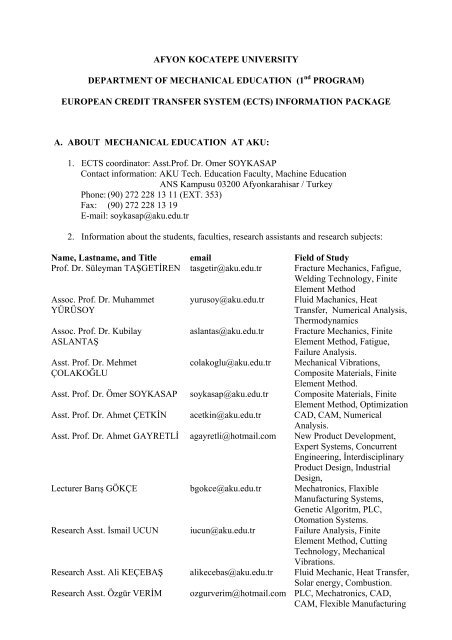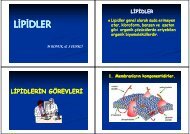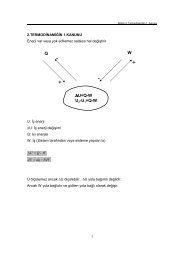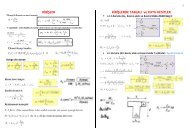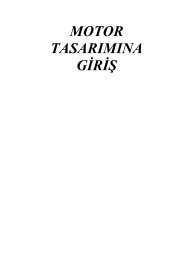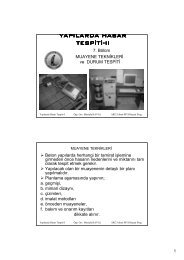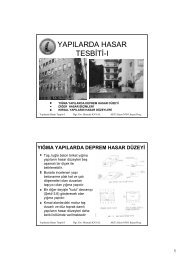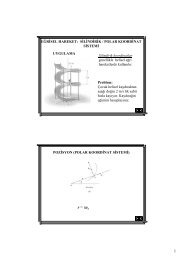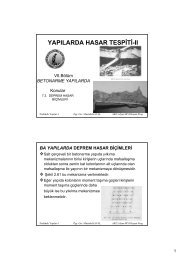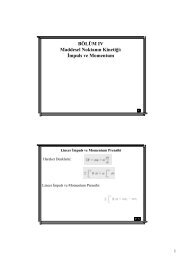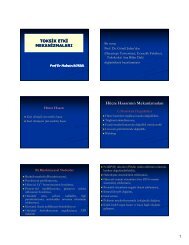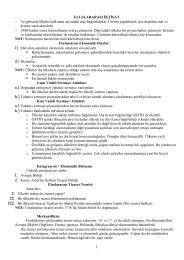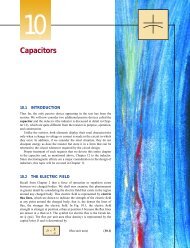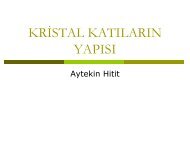ECTS guide and course catalog - Afyon Kocatepe Ãniversitesi
ECTS guide and course catalog - Afyon Kocatepe Ãniversitesi
ECTS guide and course catalog - Afyon Kocatepe Ãniversitesi
You also want an ePaper? Increase the reach of your titles
YUMPU automatically turns print PDFs into web optimized ePapers that Google loves.
a <strong>course</strong> is taken in the summer school, then, the CGPA is calculated by taking intoconsideration of the grades of the summer school <strong>course</strong>s.B. INFORMATION ABOUT THE DEGREE PROGRAMS1) Conditıons for Award of Bachelor's Diplomaa) Students must have a CGPA of not less than 2.00 <strong>and</strong> have successfullycompleted all the <strong>course</strong>s in the program in order to graduate. The students whose CGPAis between 3.00-3.49 are listed as Honour (Şeref) graduates <strong>and</strong> students whose CGPA isbetween 3.50-4.00 are listed High Honour (Yüksek Şeref) graduates. Honour <strong>and</strong> HighHonour st<strong>and</strong>ings are awarded with certificates along with the diplomas.
MACHİNE EDUCATION DEPARTMENTMACHINE TEACHING PROGRAMSEMESTER ICODE Course Name RE Theo Apl. Tot. CreditZorunlu Dersler KRE <strong>ECTS</strong>TDL-101 Turkish Language-I Z 2 0 2 - 1TAR-103History of Turkish Revolution <strong>and</strong> Principles ofAtatürk-IZ 2 0 2 - 1YAD-107 Foreign Language-I Z 2 0 2 - 1EGT-101 Introduction to Teaching Profession Z 3 0 3 3 3MAT-101 Mathematics-I Z 3 1 4 3.5 5KIM-101 General Chemistry Z 2 0 2 2 3MAK101 Technical Drawing Z 3 1 4 3.5 5MAK-103 Descriptive Geometry Z 2 0 2 2 2MAK-105 Materials Sciences-I Z 3 1 4 3.5 5ENF-101 Basics of Information Technologies Z 2 0 2 2 3TOTAL 26 3 29 19.5 30Elective Course(only one)BEG-105 Physical Education S 2 0 2 - 1GSN-101 Fine Arts S 2 0 2 - 1SEMESTER IICODE Course Name RE Theo Apl. Tot. CreditRequired Course KRE. <strong>ECTS</strong>TDL-102 Turkish Language-II Z 2 0 2 - 1TAR-104History of Turkish Revolution <strong>and</strong> Principles ofAtatürk-IIZ 2 0 2 - 1YAD-108 Foreign Language-II Z 2 0 2 - 1EGT-102 School Experience-I Z 3 0 3 3 3MAT-102 Mathematics-II Z 3 1 4 3.5 5FIZ-102 Physics Z 2 0 2 2 3ENF-102 Basics of Computer Sciences Z 2 0 2 2 3MAK-102 Professional Drawing Z 3 1 4 3.5 5MAK-106 St<strong>and</strong>ards Z 2 0 2 2 3MAK-108 Materials Sciences II Z 3 1 4 3.5 5TOTAL 24 3 27 19.5 30SEMESTER IIICODE Course Name RE Theo Apl. Tot. CreditRequired Course KRE <strong>ECTS</strong>EGT-201 Development <strong>and</strong> Learning Z 3 0 3 3 3IST-201 Statistics <strong>and</strong> Quality Control Z 3 0 3 3 3MET-201 Vocational English-I Z 2 0 2 2 3MAT-201 Mathematics-III Z 2 0 2 2 3MAK-201 Statics Z 3 0 3 3 3MAK-203 Fluids Mechanics Z 3 0 3 3 3MAK-203 Manufacturing Methods-I Z 3 3 3 4MET-207 Workshop <strong>and</strong> Technology I (Mech. Drawing-I) Z 2 4 6 4 8TOTAL 21 4 25 23 30
SEMESTER IVCODE Course Name RE Theo Apl. Tot. CreditRequired Course KRE. <strong>ECTS</strong>EGT-202 Instructional Planning <strong>and</strong> Evaluation Z 3 2 5 4 4MAK-210 Vocational English-II Z 2 0 2 2 3MAT-206 Numerical Analysis Z 2 0 2 2 3MAK-212 Dynamics Z 3 0 3 3 3MAK-202 Strength of Materials-I Z 3 0 3 3 3MAK-204 Manufacturing Methods-II Z 3 0 3 3 4MAK-208 Workshop <strong>and</strong> Technology-II (Computer Aided8Z 2 4 6 4Drawing)MAK-206 Computer Aided Drawing Programs Z 2 0 2 2 2TOTAL Z 20 6 26 23 30SEMESTER VCODE Course Name RE Theo Apl. Tot. CreditRequired Course KRE. <strong>ECTS</strong>EĞT-301 Instructional Techniques <strong>and</strong> Material4Z 2 2 4 3DevelopmentMAK-301 Strength of Materials-II Z 3 0 3 3 3MAK-303 Machine Component Design-I Z 3 0 3 3 4MAK-305 Computer Aided Design Z 3 0 3 3 4MAK-307 Basic Electricity Z 2 0 2 2 2MAK-309 Thermodynamics Z 3 0 3 3 3MAK-313 Mechanisms Z 4 0 4 4 4MAK-311 Workshop <strong>and</strong> Technology-III (Hydrolics <strong>and</strong>6Z 2 4 6 4Pnomatics Systems)TOTAL 22 6 28 25 30SEMESTER VICODE Course Name RE Theo Apl. Tot. CreditRequired Course KRE <strong>ECTS</strong>EGT-302 Classroom Management Z 2 2 4 3 4EGT-304 Special Teaching Methods-I Z 2 2 4 3 4MAK-306 Machine Component Design-II Z 3 0 3 3 4MET-304 Research Methodology Z 2 0 2 2 2MAK-306 Production Planning Z 3 0 3 3 3MAK -308 Heat Transfer Z 3 0 3 3 3MET-310 Workshop <strong>and</strong> Technology-IV (Machine6Z 2 4 6 4Design)TOTAL 21 8 29 25 30Elective Course(only two)MAK-312 Systematic Design S 2 0 2 2 2MAK-314 Stress Analysis S 2 0 2 2 2MAK-316 Industrial Measurement S 2 0 2 2 2MAK-318 Automation Techniques S 2 0 2 2 2
SEMESTER VIICODE Course Name RE Theo Apl. Tot. CreditRequired Course KRE <strong>ECTS</strong>EGT-403 School Experience-II Z 1 4 5 3 4EĞT-403 Special Teaching Methods-II Z 2 2 4 3 4MAK-401 Machine Component Design-III Z 2 0 2 2 4MAK-403 Entrepreneurship Z 2 0 2 2 3MAK-407 Materials Selection in Engineering Design Z 3 0 3 3 4MET-405 Workshop <strong>and</strong> Technology V (Machine Design-5Z 1 2 3 2II)TOTAL 15 8 23 19 30Elective Course(only two)MAK-409 Design of Serial Production System S 2 0 2 2 3MAK-411 Introduction to Finite Element Method S 2 0 2 2 3MAK-412 Machine Dynamics S 2 0 2 2 3OTO-413 Alternative Energy Systems S 2 0 2 2 3ISL-401 Business Organization S 2 0 2 2 3HUK-401 Basic Concepts of Law S 2 0 2 2 3SEMESTER VIIICODE Course Name RE Theo Apl. Tot. CreditRequired Course KRE <strong>ECTS</strong>EGT-402 Guidance Z 3 0 3 3 3EGT-404 Teaching Practice Z 2 6 8 5 5MAT-400 Graduation Thesis Z 0 2 2 1 4MAK-402 Computer Aided Manufacturing Z 3 0 3 3 4MAK-404 Production Machine Design Z 2 0 2 2 3MAK-406 Workshop <strong>and</strong> Technology-VI (Machine5Z 1 2 3 2Design-III)TOTAL 15 20 30Elective Course(only two)MET-408 Composite Materials S 2 0 2 2 3MAK-410 Mechanical Vibrations S 2 0 2 2 3MAK-412 Molding Technique S 2 0 2 2 3MAK-414 Transport Technique S 2 0 2 2 3OTO-312 Construction <strong>and</strong> Industry Machines S 2 0 2 2 3OTO-202 Fuels <strong>and</strong> Combustion S 2 0 2 2 3* A total of 60 days internship is required for a B.S. degree. Internship is credited as (thenumber of days x 8) / 30. A complete internship <strong>ECTS</strong> credit is 60 x 8 / 30 = 16.
C. DESCRIPTIONS OF UNDERGRADUATE COURSESMAT 101 MATHEMATICS – IMAT101 – MATHEMATICS - I (3-1) 3,5Year/Semester 1 st Year / 1 st Semester(<strong>ECTS</strong>:5)Type of CourseCourse ContentsPrerequisite/RecommendedObjective of the CourseTextbook / RecommendedReadingForm of TeachingForm of AssessmentLanguage of InstructionInstructorCompulsoryNumbers; Functions: Introduction, Types, SpecialFunctions; Limit, continuity. Derivatives: Differentiationrules, Newton's method for finding roots, curve sketching,maxima <strong>and</strong> minima, Mean value theorem, Taylor'sformula, l'Hopital's rule. Integration: Indefinite <strong>and</strong>definite integrals, finding areas, volumes, <strong>and</strong> arc lengths,surface areas of revolution. Transcendental functions,hyperbolic functions. Integration techniques, improperintegrals.NoneThis <strong>course</strong> is to acquaint the first year students withgeneral knowledge about functions, limit, derivative,integral <strong>and</strong> to make useful practice for using other<strong>course</strong>sGörgülü, Ali, General Mathemetics: Differantial <strong>and</strong>Integral Calculation, Osmangazi University Press; no.42.Eskişehir, 2000.Görgülü, Ali, Genel matematik: diferensiyel ve integralhesap, Osmangazi Üniversitesi yayın; no.42. Eskişehir,2000.Advanced Engineering Mathematics by Erwin Kreyszig,Wiley; 8 edition (October 9, 1998)Schaum's Outline of Advanced Mathematics forEngineers <strong>and</strong> Scientists by Murray R Spiegel, McGraw-Hill; 1 edition (June 1, 1971)LecturesOne written midterm exams (40 % each); one written finalexam (60 %)TurkishLecturer Mehmet ERENGİL; erengil@aku.edu.tr
MAK 101 TECHNICAL DRAWINGMAK101 - TECHNICAL DRAWING (3-1) 3.5Year/Semester1 st Year / 1 st Semester(<strong>ECTS</strong>:5)Type of CourseCourse ContentsPrerequisite/RecommendedObjective of the CourseTextbook / RecommendedReadingForm of TeachingForm of AssessmentLanguage of InstructionInstructorCompulsoryTechnical drawing tools <strong>and</strong> equipment; St<strong>and</strong>ards;Geometric drawings; Perspective view <strong>and</strong> types;Completion of view <strong>and</strong> principles; Dimensionalize ofsurface <strong>and</strong> surface quality marks; Drawings ofproduction illustrations <strong>and</strong> reading of them; Crosssectionmethod.NoneThis <strong>course</strong> is to acquaint the first year department ofmechanical education students with fundamental rules ofTechnical Drawing <strong>and</strong> gives them ability of application.Türkdemir K. 2005, Teknik Resim I., PamukkaleÜniversitesi.Lectures, ApplicationsOne written midterm exam (20 % ); Home works (20 %);One written final exam (60 %)TurkishAsst.Prof.Dr. Ahmet ÇETKİN; acetkin@aku.edu.tr
BIL 101 BASICS OF INFORMATION TECHNOLOGIESBIL101 - BASICS OF INFORMATION TECHNOLOGIES (2-0) 2Year/Semester1 rd Year / 1 st Semester(<strong>ECTS</strong>:3)Type of CourseCourse ContentsPrerequisite/RecommendedObjective of the CourseTextbook / RecommendedReadingForm of TeachingCompulsoryIn the lesson, the description of computer, the usage ofareas of it, the equip mental structure of computer, theworking systems, the usage of Windows XP workingsystem <strong>and</strong> the changes of its accuracy the description ofOffice programmes, the usage of MS Word workingprogramme. The formation of MS Excel calculationtableau <strong>and</strong> the techniques of basic graphic.NoneThe student, being successful in this lesson, learns thecompounds of the computer, the things which must bepaid attention during choosing computer, What theworking system is <strong>and</strong> how it manage the computer <strong>and</strong>the difference between the working system <strong>and</strong>programme. The student learn the usage of MS Word <strong>and</strong>MS Excel programmes which he will use in his educationlife.Erkan, K., (2003) Temel Bilgi Teknolojisi KullanımıAnkara: PegemA Yay. Nobel Yay.LecturesForm of Assessment Midterm exam ( % 40), Final exam (% 60)Language of InstructionInstructorTurkishLecturer Barış GÖKÇE; bgokce@aku.edu.tr
KIM 131 GENERAL CHEMISTRYKIM131 - GENERAL CHEMISTRY (2-0) 2 (<strong>ECTS</strong> : 3)Year / Semester 1 st Year / 1 st SemesterType of CourseCompulsoryCourse ContentsChemistry <strong>and</strong> materials, the structure of atom, theperiodic table <strong>and</strong> energy levels, chemical bonds,symbol, molecular formulas <strong>and</strong> equations,stoichiometri, gases, liquids <strong>and</strong> solids, solutions,chemical kinetic <strong>and</strong> chemical equilibrium, acids, bases<strong>and</strong> pH calculations, electrochemistry, chemicalthermodynamicPrerequisite / Recommended NoneObjective of the Course This <strong>course</strong> is to acquaint the first year BSc studentswith fundamental concepts of general chemistryTextbook / RecommendedReadingForm of TeachingForm of AssesmentLanguage of InstructionInstructorGeneral Chemistry (4th Edition) by John W. Hill, RalphH Petrucci, Terry W McCreary, Scott S. Perry, PrenticeHall; 4 edition (March 2, 2004)General Chemistry (with CD-ROM <strong>and</strong> InfoTrac) byKenneth W. Whitten, Raymond E. Davis, Larry Peck,George G. Stanley, Brooks Cole; 7 edition (April 18,2003)LecturesOne written midterm exams (30 %), reports (20 %), onewritten final exam (50 %)TurkishAssist.Prof.Dr.Meltem DİLEK
EGT 101 INTRODUCTION TO TEACHING PROFESSIONEGT101 - INTRODUCTION TO TEACHING PROFESSION (3-0) 3 (<strong>ECTS</strong>: 3)Year/SemesterType of CourseCourse ContentsPrerequisite/RecommendedObjective of the CourseTextbook / RecommendedReadingForm of TeachingForm of AssessmentLanguage of InstructionInstructor1 st Year / 1 st SemesterCompulsoryCharacteristics <strong>and</strong> principles of teaching profession,school <strong>and</strong> classroom contexts, alternative perspectives ineducation, social, psychological, economical,philosophical <strong>and</strong> historical foundations of education,Turkish education systemNoneUnderst<strong>and</strong>ing the importance of education.Teaching the social dynamics which direct the educationalapplications.Underst<strong>and</strong>ing the difference between traditional <strong>and</strong>modern education applications.Recognition of school as a social system.Underst<strong>and</strong>ing the importance of teaching professionAchieving the typical characteristics of teachingprofessionÖğretmenlik Mesleğine Giriş, (Edt) K.KESKİNKILIÇ,G.OCAK, S.AKBABA, PegemA Yayıncılık, Ankara,2005Öğretmenlik Mesleğine Giriş, (Edt.)Yüksel ÖZDEN,PegemA Yayıncılık, Ankara, 2002.Öğretmenlik Mesleğine Giriş, Özcan DEMİREL, ZekiKAYA, Coşkun BAYRAK, PegemA Yayıncılık, Ankara.A First-Year Teacher's Guidebook, 2nd Ed. by BonnieWilliamson, Marilyn Pribus, Kathy Hoff, DynamicTeaching Company; 2nd edition (September 1998)LecturesOne written midterm exams (40 % each); one written finalexam (60 %)TurkishProf.Dr. Süleyman TAŞGETİREN; tasgetir@aku.edu.tr
TAR 103 HISTORY OF TURKISH REVOLUTION AND PRINCIPLESOF ATATURK - ITAR103 - HISTORY OF TURKISH REVOLUTION AND PRINCIPLES OF ATATURK-I(2-0) 0 (<strong>ECTS</strong>: 1)Year/Semester1 st Year / 1 st SemesterType of CourseCompulsoryCourse ContentsOttoman innovation, World War I, Independent War,Turkish revolution, Ataturk’s principles.Prerequisite/RecommendedObjective of the CourseNoneIt gives information about Turkish history comparingEurope to Turkish reulution <strong>and</strong> Ataturk’s principles.Textbook / RecommendedReadingForm of TeachingForm of AssessmentLanguage of InstructionInstructorTuran, R., ve diğerleri, Atatürk İlkeleri ve İnkılap Tarihi,2004.Kemal Atatürk : Transforming the Image of a Nation byBernard Lewis, Etem Tem, Yapı Kredi (January 1, 1995)LecturesOne written midterm exam (40%); one written final exam(60%)TurkishLecturer Mustafa KARAZEYBEK
TDL 101 TURKISH LANGUAGE – ITDL101 - TURKISH LANGUAGE – I (2-0) 0 (<strong>ECTS</strong>: 1 )Year/ Semester 1 st Year / 1 st SemesterType of CourseCompulsoryCourse ContentsThe relationship between language <strong>and</strong> culture, the statusof Turkish among the languages worldwide <strong>and</strong> itshistory, the grammar of Anatolian TurkishPrerequisite/ Recommended NoneObjective of the Course At the end of the year the freshmen will be aware ofhis/her mother tongue’s grammar rules as well as itssemantics <strong>and</strong> phonetics, apart from this they will be ableuse the language in an accurate way considering theserules <strong>and</strong> they will have consciousness regarding thevalue of their native language.In every field of study <strong>and</strong> working after graduation theskill built for using the native tongue efficiently <strong>and</strong>accurately to express one’s ideas is vital in every aspect.Textbook/ RecommendedReadingTurkish Language <strong>and</strong> Writing Skills, <strong>Afyon</strong> Education,Health, Science <strong>and</strong> Research Society Press, <strong>Afyon</strong> 2004All reference materials, without any criteria, regardingTurkish Language <strong>and</strong> Writing Skills, Turkish - TurkishDictionary, Orthography Guide, Punctuation Guide,Dictionary of Idioms, Dictionary of Proverbs, Periodicals-Türk Dili ve Kompozisyon Bilgileri, <strong>Afyon</strong> EğitimSağlık ve Bilim Araştırma Vakfı Yayını, <strong>Afyon</strong> 2004;-Türk Dili ve Kompozisyon Bilgileri içerikli tümkaynaklar-Türkçe Sözlük, İmla Kılavuzu, Deyimler Sözlüğü,Atasözleri Sözlüğü-Süreli yayınlarBeginner's Turkish (Beginner's (Foreign Language)) byFuad A. Attaoullah, Hippocrene Books (December 1998)Elementary Turkish by Lewis Thomas, DoverPublications (April 1, 1986)Teach Yourself Turkish Complete Course Audiopackageby Asuman Celen-Pollard, David W. Pollard, AsumanCelen-Pollard, David Pollard, McGraw-Hill; 3 edition(March 1, 2004)LectureForm of TeachingForm of Assessment T.L.-I One written midterm exam (% 40 each) ; Onewritten final exam (60 %)T.L.-II One written midterm exam (% 40 each) ; Onewritten final exam (60 %)Language of Instruction TurkishInstructorLecturer Erhan SOLMAZ
YAD 107 FOREIGN LANGUAGE - I (English)YAD 107 - FOREIGN LANGUAGE - I (English) (2-0) 0 (<strong>ECTS</strong>: 1 )Year/Semester1 st Year / 1 st SemesterType of CourseCompulsoryCourse ContentsThe verb TO BE; a <strong>and</strong> an; singular <strong>and</strong> plural nouns; thesimple present tense; can <strong>and</strong> can't; <strong>and</strong>, but, or;possessive nouns; adjectives; any <strong>and</strong> some; there is <strong>and</strong>there are; count <strong>and</strong> non-count nouns; possessiveadjectives; infinitives with like, want, I'd like <strong>and</strong> need';let's, the present progressive tense; questions <strong>and</strong>sentences with think; imperatives, the simple pasttense(verb TO BE)Prerequisite/Recommended NoneObjective of the Course The purpose of the lesson is to help students see how toput words together in English <strong>and</strong> help them think about<strong>and</strong> improve their English communication. The lessonpromotes the idea that students can be better learners ifthey think, talk, <strong>and</strong> write about what they learn.Textbook / RecommendedReadingForm of Teaching-Briggs, S<strong>and</strong>ra J.; Grammar: Strategies <strong>and</strong> Practice,Beginning, Longman-Azar, Betty Schrampfer; Basic English Grammar;Longman.LecturesForm of Assessment a mid-term ( 40 %), a final exam ( 60 % )Language of InstructionInstructorEnglishLecturer İlyas SAYKILI
BES 101 PHYSICAL EDUCATIONBES101 - PHYSICAL EDUCATION (2-0) 0(<strong>ECTS</strong>:1)Year/Semester1 st Year / 1 st SemesterType of CourseSelectiveCourse ContentsRelated to Atletism Branch; running, throwing <strong>and</strong>jumping, free gymnastics. Team sports: football,volleyball, basketball, basic abilities about h<strong>and</strong>ballPrerequisite/RecommendedObjective of the CourseTextbook / RecommendedReadingForm of TeachingForm of AssessmentLanguage of InstructionNoneTo provide the teenagers’ physical, mental <strong>and</strong> socialdevelopement by procuring the basic knowledge, ability,<strong>and</strong> habits about Physical Education <strong>and</strong> sports.Aracı. H., 1998, Schools Physıcal Educatıon (in Turkish)Hazar. M.,1997, Physıcal Educatıon <strong>and</strong> Game Educatıonin Sports (in Turkish)Aracı, H., Okullarda Beden Eğitimi, 1998Hazar. M., Beden Eğitimi ve Sporda Oyun Eğitimi, 1997Physical Education for Lifelong Fitness: The PhysicalBest Teacher's Guide by Physical Best, Human Kinetics,Nat'l Assoc for Sport & PE, Human Kinetics Publishers;2nd edition (August 30, 2004)Expression <strong>and</strong> practicalOne practical midterm exam(%50); one practical finalexam (%50)TurkishInstructor -
GSF 101 FINE ARTSGSF101 - FINE ARTS (2-0) 0Year/SemesterType of CourseCourse ContentsPrerequisite/RecommendObjective of the CourseTextbook / RecommendedReadingForm of Teaching1 st Year / 1 st Semester(<strong>ECTS</strong>:1)SelectiveDefinition of art: general meaning of art, specifik meaningof art, calssifications of fine art, visual arts(the plasticarts) auditory arts(phonetic arts) mixed shapes(dramaticarts) Aesthetic; fine as general,fine as aesthetic value,aesthetic theories, function of art, social functions of art,psycnological functions of art, cultural functions ofart.corruption at art; KITSCH problem;popular culture<strong>and</strong> kitsch ,arabesque <strong>and</strong> art,general look to World ArtHistory, ciivilization chronology, terms at Europe art,abstract art trends, Turkish art <strong>and</strong> 20th century generalwiev of Turkish paints, work investigation modern art toinvestigate different visual document relating to İstanbul’s<strong>and</strong> Venedik’s bienalles.NoneThis fine art elective <strong>course</strong> that is given in two years,purposed acquiring art culture limitation of general arteducation. Another style of exposition to comphended tothe student; art; that is at definited dimension , make morehumanist, enhance life, about art’s nature <strong>and</strong> various kinddiscipline to give knowledge ability <strong>and</strong> intelligence to thestudent.making them more humanist more interragaters<strong>and</strong> more sozialized is main goal of this <strong>course</strong>.Target treatments; to underst<strong>and</strong> the difficulty atdefinition of art concept, to define art <strong>and</strong> craft with truecontents, to grasp different art discipline’s nature <strong>and</strong>analyse the systems, to solve the problem aboutdegeneration at art, to make more category of different artdisciplines,cluthing art origin <strong>and</strong> defining the artsfunction.CD, DVD, MP3, various art journal-Tunalı , İsmail ;İ. Estetik, Remzi Kitabevi-Turani, A. Sanat Terimleri Sözlüğü; Eczacıbaşı SanatAnsiklopedisi, Remzi Kitabevi-Turani, Adnan ; Çağdaş sanat Felsefesi, Remzi Kitabevi;The Art Book For Children by Editors of Phaidon Press,Phaidon Press (October 1, 2005)LecturesForm of Assesmentone written midterm exam (40 %); one written final exam(60 %)Language of Instruction TurkishInstructor -
MET 101 MATERIALS SCIENCES - IMET101 - MATERIALS SCIENCES - I (3+1)4Year / Semester1 rd Year / 1 st Semester(<strong>ECTS</strong>:5)Type of CourseCompulsoryCourse ContentsIntroduction, Atomic Structure of Metals, TheoreticFundamentals of Crystallization Process, Relationbetween Microstructure <strong>and</strong> Undercooled of Metals,Polymorph Transition in Metals, Studying Methods ofMicrostructure of Metals <strong>and</strong> Alloys, Fundamentals ofRecrystallization Process, Mechanical Properties derivedfrom Static <strong>and</strong> Dynamic Tests, Hardness Test, FatigueTest, Creep Test <strong>and</strong> Their PropertiesPrerequisite / Recommended NoneObjective of the CourseTextbook / RecommendedReadingForm of TeachingHaving information about subjects of lecture contentDonald R. Askel<strong>and</strong>, Trans. Erdogan M., (1998) Science<strong>and</strong> Engineering of Materials Ankara, Nobel Publication.Lahtin Yu. M. Metal science (1998) Moscow, GulaevA.S. (2000) Metal science Moscow, G. Said (2002) Textnotes A.K.U.LecturesForm of Assesment Midterm exam (% 40), Final exam (% 60)Language of InstructionInstructorTurkishAsst. Prof. Dr. Yılmaz YALÇIN; yyalcın@aku.edu.tr
IST 201 STATISTICS AND QUALITY CONTROLIST201 - STATISTIC AND QUALITY CONTROL (3-0) 3Year / SemesterType of Course2 nd Year / 1 st SemesterCompulsory(<strong>ECTS</strong>:3)Course Contents Introduction <strong>and</strong> Basis Concepts. Heap, variable,classifying, measuring level, equal intermitted measuringlevel, calculate measuring level. Data bases gathered. TheAim of Statistics. Using Data Bases: Showing in case ofTable, multitude dispersion, graphics, histogram, diagram,central education criterions: Arithmetic mean, median(hydrangea), mod (peak value), geometric mean,harmonic mean, separation, changing coefficient.Probability: probability concept, separated events,definition of probability, some probability rules,conditional probability, permutation <strong>and</strong> combination.Dispersions: Binomial dispersion, Poisson dispersion,normal dispersion, X 2 (ki square) dispersion. Sampling:Ki square tests, ki square goodness harmony tests.Relation coefficients: Correlation coefficient, Spcormannlimit correlation. Correlation: Chosen of suitable model,most little squares method. Regrasyon: Chosen of suitablemodel, most little squares method.Prerequisite/Recommended NoneObjective of the Course In this <strong>course</strong>, theoretical knowledge education aboutstatistic <strong>and</strong> quality control is earned to students.Textbook/RecommendedReadingForm of Teachingİstatistik, O. Düzgüneş, Yaygın Y. O. Basınevi, Ankara,1998LecturesForm of AssesmentLanguage of InstructionInstructorOne Written Midtern Exam ( % 40); One Written FinalExam (% 60)TurkishAssist. Prof. Dr. Yılmaz İÇAĞA
MAK 102 PROFESSIONAL DRAWINGMAK102 - PROFESSIONAL DRAWING (3-1) 3.5Year/SemesterType of CourseCourse ContentsPrerequisite/RecommendedObjective of the CourseTextbook / RecommendedReadingForm of Teaching1 st Year/ 2 nd Semester(<strong>ECTS</strong>:5)CompulsoryComplete <strong>and</strong> detail production drawings of the groupillustrations which have perspective view; Simplest<strong>and</strong>ard support elements; Pulley systems <strong>and</strong> similardrawings; Gears; Journal <strong>and</strong> roller bearings; Numberingprinciples of illustrations, Assembly drawingsTechnical DrawingThis <strong>course</strong> is to acquaint the first year department ofmechanical education students with fundamental rules ofVocational Drawing <strong>and</strong> gives them ability of application.Türkdemir K. 2005, Uygulamalı Teknik Resim,Pamukkale üniversitesi yayınevi.Lectures, practiseForm of Assessment One written midterm exam (20 % ); Home works (20 %);One written final exam (60 %)Language of Instruction TurkishInstructorAsst.Prof.Dr. Ahmet ÇETKİN; acetkin@aku.edu.tr
MAK 106 STANDARDSMAK106 – STANDARDS (2-0) 2(<strong>ECTS</strong>:3)Year/Semester1 st Year / 2 nd SemesterType of CourseCompulsoryCourse ContentsDescription of st<strong>and</strong>ard term; Purpose of st<strong>and</strong>ardization;Assortment of st<strong>and</strong>ard; Turkish st<strong>and</strong>ard; TS, ISO, EN,DIN; TS 88; Investigation of recent development on thetechnical drawing;Prerequisite/Recommended NoneObjective of the Course This <strong>course</strong> is to acquaint the first year department ofmechanical education students with fundamental conceptsof St<strong>and</strong>ards;Textbook / RecommendedReadingForm of TeachingTürkdemir K. 2005, St<strong>and</strong>art Makine elemanları,Pamukkale Üniversitesi.LecturesForm of Assessment One home work (40 %); One final project (60 %)Language of InstructionInstructorTurkishAsst.Prof.Dr. Ahmet Çetkin; acetkin@aku.edu.tr
EGT 201 DEVELOPMENT AND LEARNINGEGT201 - DEVELOPMENT AND LEARNING (3-0) 3 (<strong>ECTS</strong>: 3)Year/Semester2 nd Year / 1 st SemesterType of CourseCourse ContentsPrerequisite/RecommendedObjective of the CourseTextbook / RecommendedReadingForm of TeachingForm of AssessmentLanguage of InstructionInstructorCompulsoryBasic Principles of Development, Developmental Periods<strong>and</strong> DutiesStages of physical <strong>and</strong> motor development.Piaget’s Theory of Cognitive DevelopmentTheories of personality development (PsychosexualPersonality Theory, Psychosocial Personality Theory, viewpoints of C.Rogers <strong>and</strong> A.Maslow mental health)Theories of moral development (J.Piaget’s Model of MoralDevelopment, L.Kohlberg Cognitive Theory of MoralDevelopment)Behavioral <strong>and</strong> Cognitive learning approachesLearning styles <strong>and</strong> strategiesNoneDuring the <strong>course</strong>, students learn basic concepts <strong>and</strong>principles of development <strong>and</strong> learning, physical <strong>and</strong>motor development, cognitive development, personalitydevelopment, moral development, learning according tobehavioral <strong>and</strong> cognitive approach, learning styles <strong>and</strong>strategiesGelişim ve Öğrenme Psikolojisi, Ş.YAPICI, M.YAPICI,Anı Yayıncılık, Ankara, 2005Gelişim Öğrenme ve Öğretim, Prof. Dr. NuraySENEMOĞLU, Gazi Yayıncılık, Ankara, 2004Gelişim ve Öğrenme Psikolojisi, Binnur YEŞİLYAPRAKBetül AYDIN, Gürhan CAN, PegemA YayıncılıkAdult Learning <strong>and</strong> Development: Perspectives fromEducational Psychology (The Educational PsychologySeries) by M. Cecil Smith (Editor), Thomas Pourchot(Editor), Lawrence Erlbaum Associates (February 1998)Reflections in Learning <strong>and</strong> Professional Development byMOON, Jennifer Mooon, FALMER/KP; 1 edition (January1, 2001)LecturesTwo written midterm exams (20 % each); one written finalexam (60 %)TurkishLecturer Süleyman KARATAŞ
MAK203 - FLUIDS MECHANICS (3-0) 3Year/SemesterType of CourseCourse ContentsPrerequisite/RecommendedMAK 203 FLUIDS MECHANICS2 nd Year / 1 st Semester(<strong>ECTS</strong>:3)CompulsoryProperties of Fluid. Fluid Statics (manometers, pressuremeasurement , forces on surface (plane ,curved), buoyantforce, lineer acceleration <strong>and</strong> rotation). Fluid FlowConcepts <strong>and</strong> Basic Equation (control volume,continuity, energy, momentum, Euler’s <strong>and</strong> the Bernoulliequations, applications of the linear momentumequation). Dimensional Analysis <strong>and</strong> DynamicSimilitude. Viscous Effect (flow between parallel plates,pipe flow ,turbulent flow)NoneObjective of the CourseTextbook / RecommendedReadingForm of TeachingForm of AssessmentLanguage of InstructionInstructorThis <strong>course</strong> is to acquaint the second year department ofmechanical educationl students with fundamentalconcepts of fluids mechanics <strong>and</strong> viscous fluid flowanalyses.Streeter,V. L. ve Wylie, E. B. “Fluid Mechanics”McGraw-Hill, 1983LecturesOne written midterm exam (40 % ); one written finalexam (60 %)TurkishAssoct.Prof.Dr. Muhammet Yürüsoy; yurusoy@aku.edu.tr
MAK 201 STATICSMAK201 - STATICS (3-0) 3Year/SemesterType of CourseCourse ContentsPrerequisite/RecommendedObjective of the CourseTextbook / RecommendedReadingForm of TeachingForm of AssessmentLanguage of InstructionInstructor2 nd Year / 1 st Semester(<strong>ECTS</strong>:3)CompulsoryStatics of particles <strong>and</strong> rigid bodies. Equivalent systems offorces. Distributed forces; centroids. Applications totrusses, frames, machines, beams, <strong>and</strong> cables. Friction.Moments of inertia.NoneThis <strong>course</strong> is to acquaint the second year department ofmechanical education students with fundamental conceptsof engineering mechanics analyses.R C Hibbeler. Engineering Mechanics: Statics. 6thedition, 1992. Macmillan Publishing Company.Lectures using datashowOne written midterm exam (40 % ); one written finalexam (60 %)Turkish/EnglishAsst.Prof.Dr. Mehmet ÇOLAKOĞLU;colakoglu@aku.edu.tr
MAK 307 BASIC ELECTRICITYMAK307 – BASIC ELECTRICITY (2-0) 2(<strong>ECTS</strong>:2)Year / Semester3 rd Year / 1 st SemesterType of CourseCompulsoryCourse Contents Electrical terms; electric load, force, potentialdiscrimination, current, power, energy. Electricalelements; resistance, bobbin, condenser. R, L, C elementsserial, parallel <strong>and</strong> serial-parallel connections <strong>and</strong>equivalence. Ohm rule, Kirchhoff rule. Electricmeasurement tools <strong>and</strong> connection to circuit; ammeter,voltmeter, wattmeter, multimeter. Security precaution;grounding <strong>and</strong> fault current protection relays, securitydirections. Definitions of basis electric-electronic circuitelements; resistance, bobbin, condenser, diode, zenerdiode, transistor. Catalog information <strong>and</strong> strength test.Prerequisite/Recommended NoneObjective of the CourseTextbook/RecommendedReadingForm of TeachingForm of AssesmentLanguage of InstructionInstructorIn this <strong>course</strong>, theoretical knowledge education aboutelectrical therms <strong>and</strong> problems at practical applicationsare earned to students.LecturesOne Written Midtern Exam ( % 40); One Written FinalExam (% 60)TurkishLecturer Bekir ÇENGELCİ
MAK 313 MECHANISMSMAK313 - MECHANISMS (4-0) 4(<strong>ECTS</strong>:4)Year/Semester3 rd Year / 1 st SemesterType of CourseCompulsoryCourse ContentsIntroduction to mechanism techniques, Planer kinematicsof a rigit body, kinetic analysis of mechanisms, linearmechanic systems.Prerequisite/RecommendedObjective of the CourseTextbook / RecommendedReadingForm of TeachingNoneThis <strong>course</strong> is to acquaint the third year department ofmechanical education students with fundamental conceptsof engineering mechanisms analyses.R C Hibbeler. Engineering Mechanics: Dynamics. 6thedition, 1992. Macmillan Publishing Company.E Söylemez, Mechanism Techniques. Prestij AjansMatbaacılık.LecturesForm of Assessment Homework (20%), one written midterm exam (30 % );one written final exam (50 %)Language of Instruction TurkishInstructorAsst. Prof. Dr. Mehmet ÇOLAKOĞLU;colakoglu@aku.edu.tr
MAK 204 STRENGTH OF MATERIALS - IMAK204 - STRENGTH OF MATERIALS -I (3-0) 3(<strong>ECTS</strong>:3)Year / Semester2 nd Year / 2 nd SemesterType of CourseCompulsoryCourse ContentsGeneral concepts, tensile-elongation test, Hooke rule.Safety factor. Fatigue, tensile, pressure, slips stresses.Inertia moment, bending stress, force-moment graphics.Bending quantity. Sprain, compound stress. Stress energy,Castigliano theorem.Prerequisite/Recommended NoneObjective of the CourseTextbook/RecommendedReadingForm of TeachingForm of AssesmentLanguage of InstructionInstructorIn this <strong>course</strong>, theoretical knowledge education aboutstrength of materials <strong>and</strong> basis concepts of endurance areearned to students.Mukavemet, Tekin ÖZBEK, Birsen Basınevi.LecturesOne Written Midtern Exam ( % 40); One Written FinalExam (% 60)TurkishAsst.Prof.Dr. Ömer SOYKASAP; soykasap@aku.tr
MAK 210 WORKSHOP AND TECHNOLOGY - II (Com. Aided Drawing)MAK210 - WORKSHOP AND TECHNOLOGY - II (CAD) (2-4) 6(<strong>ECTS</strong>:8)Year/Semester2 nd Year / 2 nd SemesterType of CourseCompulsoryCourse ContentsUsing computer aided drawing programme, Solidmodelling <strong>and</strong> Drawings applications of a full product ismade.Prerequisite/RecommendedObjective of the CourseTextbook / RecommendedReadingForm of TeachingForm of AssessmentLanguage of InstructionInstructorNoneThis <strong>course</strong> is to ability of application the second yeardepartment of mechanical education students withcomputer aided drawings;Nalbant, M. Autocad 2004, Beta Yayınları, 2004Lectures, practiseOne drawings practise work (40 %); One final solid modelproject (60 %)TurkishAsst.Prof.Dr. Ahmet ÇETKİN; acetkin@aku.edu.tr
MET 102 MATERIALS SCIENCES – IIMET102 - MATERIALS SCIENCES - II (3+1) 4Year / Semester1 st Year / 2 nd Semester(<strong>ECTS</strong>:5)Type of CourseCompulsoryCourse ContentsFundamentals of Alloy Theory, Solid solution <strong>and</strong>Chemical Compounds, Description of Phase Rule <strong>and</strong>Phase Diagrams, Fundamentals of Phase Diagrams ofSoluble <strong>and</strong> Insoluble, Phases <strong>and</strong> occurred Reactions in :Fe-Fe3C Equilibrium Diagram, Effect to MechanicalProperties of Steel of Continuously Elements, Effect to ;Thermokinetic Diagrams of Steels of Alloy Elements, jMechanism of Occurred Graphitisation Process in CastIrons <strong>and</strong> Effect to Cast Iron Mechanical Properties ofGraphite.Prerequisite / Recommended NoneObjective of the CourseTextbook / RecommendedReadingForm of TeachingHaving information about subjects of lecture contentDonald R. Askel<strong>and</strong>, Trans. Erdogan M., (1998) Science<strong>and</strong> Engineering of Materials Ankara, Nobel Publication.Lahtin Yu. M. (1998) Metal science, Moscow, GulaevA.S. Metal science (2000) Moscow, G. Said (2002) Textnotes A.K.U.Lectures, PracticesForm of Assesment Midterm exam ( % 40), Final exam (% 60)Language of InstructionInstructorTurkishAsst.Prof.Dr. Yılmaz YALÇIN; yyalcın@aku.edu.tr
MAK - 305 COMPUTER AIDED DESIGNMAK - 305 COMPUTER AIDED DESIGN (3-0)3 (<strong>ECTS</strong>:4)Year/SemesterType of CourseCourse ContentsPrerequisite/Recommended3rdYear/ 1st semesterCompulsoryDescription of basic solid modeling programs, Propertiesof common; Systems of coordinate; Workplane; Moduls;Systems of mesh model; Systems of Surface model;Systems of solid model; Practices (Pro-Engineering,Mechanical desktop, Solid-works, Inventor, Catia)NoneObjective of the CourseTextbook / RecommendedReadingForm of TeachingForm of AssessmentLanguage of InstructionInstructorThis <strong>course</strong> is to acquaint the second year department ofmechanical educationl students with fundamentalconcepts of solid modelling with computer aidded.Nalbant, M. Autocad 2004, Beta Yayınları, 2004SolidWorks Lecture NotesLectures <strong>and</strong> ApplicationsOne drawings practise work (40 %); One final solid modelproject (60 %)TurkishAssist. Prof. Dr. Ahmet Gayretli; agayretli@hotmail.com
MAK- 309 THERMODYNAMICSMAK- 309 THERMODYNAMICS (3-0)3 (<strong>ECTS</strong>:3)Year/Semester3rdYear / 1st semesterType of CourseCompulsoryCourse ContentsGases. Deviation from ideality in gases. The first law ofthermodynamics, internal energy, state function,application of the first law in ideal gas processes,revesible <strong>and</strong> irreversible processes, heat, work. Thesecond law of the thermodynamics, Carnot cycle, entropy,entropy changes in various processes. Pure substance.Engine cycles (Otto, Diesel, Mixing..)Prerequisite/Recommended NoneObjective of the CourseTextbook / RecommendedReadingForm of TeachingForm of AssessmentLanguage of InstructionInstructorThis <strong>course</strong> is to acquaint the third year department ofmechanical educationl students with the first <strong>and</strong> secondlaw of thermodynamics , entropy, pure substance <strong>and</strong>engine substance.Yunus Çengel , Michael A. Boles, Çeviri(TanerDerbentli)“Mühendislik Yaklaşımı ile Termodinamik”,Literatür Yayıncılık.LecturesOne written midterm exam (40 % ); one written finalexam (60 %)TurkishAsso. Prof. Dr. Muhammet Yürüsoy; yurusoy@aku.edu.tr
MAK-303 MACHINE COMPONENT DESIGN - IMAK-303 MACHINE COMPONENT DESIGN - I (3-0)3 (<strong>ECTS</strong>:4)Year/SemesterType of CourseCourse ContentsPrerequisite/RecommendedObjective of the CourseTextbook / RecommendedReadingForm of TeachingForm of AssessmentLanguage of InstructionInstructor3rdYear / 1st SemesterCompulsoryGeneral concepts, stress analysis, compound stress, failuretheorise. Fatigue, factor of safety. Notch, size, surface <strong>and</strong>other factors. Material selection. Joining rivets, welding,soldering.NoneEducation <strong>and</strong> training of fundamental knowledge ofmechanical component design.-Makine Elemanları I,II, III, IV. – Mustafa Akkurt - 1996.-www.teknolojikarastirmalar.com - 2006.-Mechanical Engineers’s Data H<strong>and</strong>book-James Carvill -2003.LecturesOne written midterm exams (25 %), reports (25 %), onewritten final exam (50 %)TurkishProf. Dr. Suleyman TASGETIREN; tasgetir@aku.edu.tr
EGT-301 INSTRUCTIONAL TECHNICS AND MATERIALDEVELOPMENTEGT 301 INSTRUCTIONAL TECHNICS AND MATERIAL DEVELOPMENT(2-2)3(<strong>ECTS</strong>: 4)Year/Semester3rd Year / 1st SemesterType of CourseCourse ContentsPrerequisite/RecommendedObjective of the CourseTextbook / RecommendedReadingForm of TeachingForm of AssessmentLanguage of InstructionInstructorCompulsoryCharacteristics of various instructional technologiesThe place <strong>and</strong> the use of technologies in instructionalprocessDevelopment of teaching materials trough instructionaltechnologies (worksheets, transparencies, slides,videotapes, computer-based instructional material etc.)Assessment of various teaching materials.NoneIn this <strong>course</strong>, students comprehend development ofeducational technology, advantages <strong>and</strong> disadvantages ofeach educational technology material, learn to developdifferent instructional materials <strong>and</strong> the usage ofinstructional technology materials.Öğretim Teknolojileri ve Materyal Geliştirme, Halil İ.YALIN, Nobel Yayınları, Ankara, 2004.Öğrenme Öğrenme Teknikleri ve Materyal Geliştirme,Yrd. Doç. Dr. Çetin BAYTEKİN, Anı Yayıncılık, Ankara.Öğretim Teknolojileri ve Materyal Geliştirme, RaufYILDIZ, Konya, 2004.Instructional Technology And Media for Learning &Clips from the Classroom by Sharon E. Smaldino, JamesD. Russell, Robert Heinich, Michael Molenda, CathyCavanaugh, Prentice Hall; 8th Pkg edition (November 16,2005)Trends <strong>and</strong> Issues in Instructional Design <strong>and</strong> Technologyby Robert Reiser, John V. Dempsey, Prentice Hall; 1stedition (August 23, 2001)Instructional Technology: Foundations by Robert M.Gagne (Editor), Lawrence Erlbaum Associates (February1987)Instructional Technology for Teaching <strong>and</strong> Learning:Designing Instruction, Integrating Computers, <strong>and</strong> UsingMedia by Timothy J. Newby, James Lehman, JamesRussell, Donald A. Stepich, Prentice Hall; 2nd edition(August 9, 1999)LecturesOne written midterm exams (40 %); one written finalexam (60 %)TurkishLecturer Bekir ÇENGELCİ
MET-304 RESEARCH METHODOLOGYMET-304 RESEARCH METHODOLOGY (2-0) 2 (<strong>ECTS</strong>: 2)Year/Semester3rd Year / 2nd SemesterType of CourseCourse ContentsPrerequisite/RecommendedObjective of the CourseTextbook / RecommendedReadingForm of TeachingForm of AssessmentLanguage of InstructionInstructorCompulsoryIn this <strong>course</strong>, students are required to conduct a literatureor experimental study on special topic <strong>and</strong> write a paperaccording to the academic manuscript writing rules. Anoral presentation of these papers may also be requested.NoneTo improve the ability of the students to do research, writea report, <strong>and</strong> prepare a presentation.Research Methodology : A Step-by-Step for Beginners byRanjit Kumar, Sage Publications Ltd; 2nd edition (July15, 2005)Research Design: Qualitative, Quantitative, <strong>and</strong> MixedMethods Approaches by John W. Creswell, SagePublications, Inc; 2nd edition (July 15, 2002)Students will do literature survey, experimental work, ona specific topic <strong>and</strong> write a paper <strong>and</strong> prepare apresentation, participate in discussions. A variety oftechniques can be used separately or together.One written midterm exam (40 %); one written final exam(60 %)TurkishAsst.Prof.Dr. Ömer SOYKASAPsoykasap@aku.edu.tr
MAK-306 MACHINE COMPONENT DESIGN - IIMAK-306 MACHINE COMPONENT DESIGN - II (3-0)3 (<strong>ECTS</strong>:4)Year/SemesterType of CourseCourse ContentsPrerequisite/RecommendedObjective of the CourseTextbook / RecommendedReadingForm of TeachingForm of AssessmentLanguage of InstructionInstructor3rd Year / 2nd SemesterCompulsoryScrews <strong>and</strong> nuts. Analysis of spindles. Wedges, Ball-Journal bearings. Power transmission; Friction disks,Gears, spur, helical, bevel, worm. Sprockets, V belts, flatbelts, Couplings, clutches, brakes.NoneEducation <strong>and</strong> training of fundamental knowledge ofmechanical component design.-Makine Elemanları I,II, III, IV. – Mustafa Akkurt - 1996.-www.teknolojikarastirmalar.com - 2006.-Mechanical Engineers’s Data H<strong>and</strong>book-James Carvill -2003.LecturesOne written midterm exams (25 %), reports (25 %), onewritten final exam (50 %)TurkishProf. Dr. Suleyman TASGETIREN; tasgetir@aku.edu.tr
MAK311- WORKSHOP AND TECHNOLOGY-III (HYDROLICS ANDPNEUMATICS SYSTEMS)MAK311- WORKSHOP AND TECHNOLOGY-III (HYDRAULICS AND PNEUMATICSSYSTEMS) (2-4) 4 (<strong>ECTS</strong>:6)Year/SemesterType of CourseCourse ContentsPrerequisite/RecommendedObjective of the CourseTextbook / RecommendedReadingForm of Teaching3 rd Year/1st semesterCompulsoryIn this lesson, what are the hydraulics system? the basecycle elements of the hydraulics systems, the features ofthe hydraulic fluid ,the hydraulic comm<strong>and</strong> elements, thepractice areas, the examples to the problem solution <strong>and</strong>their practices in education set.Pneumatics systems, the base cycle elements of thepneumatics systems, their usage areas, the advantages <strong>and</strong>disadvantages of the pneumatics systems, the comm<strong>and</strong>elements of the pneumatic systems, the working elementof the pneumatic systems, the design of the system, thesolution of problem, <strong>and</strong> the practice of the problems ineducation set <strong>and</strong> their simulation.NoneWith the success of this lesson, the student can know thehydraulics <strong>and</strong> pneumatics systems, the elements <strong>and</strong> thecycle elements <strong>and</strong> also can produce solutions for theproblems.Taşgetiren, S., Gökçe, B., (2004) Uygulamalı Endüstriyelotomasyon, <strong>Afyon</strong>Lectures, PracticeForm of Assessment Midterm exam ( % 40), Final exam (% 60)Language of InstructionInstructorTurkishLecturer Barış GÖKÇE; bgokce@aku.edu.tr
EGT 102 SCHOOL EXPERIENCE IEGT- 102 SCHOOL EXPERIENCE I (3-0)3 (<strong>ECTS</strong> 3)Year/Semester1st year /2nd semesterType of CourseCourse ContentsPrerequisite/RecommendedCompulsoryIntroducing the students to the school environment,pupils, <strong>and</strong> teaching profession in their major; observedifferent aspects of the educational process (schoolorganization, school administration, daily routines,school-family cooperation, school resources, problemsetc.) under the supervision of a mentor.NoneObjective of the CourseTextbook / RecommendedReadingForm of TeachingInforming the students about industrial high-shcools <strong>and</strong>their functions.LecturesForm of Assessment I. Mitterm exam (%50); final exam (%50)Language of InstructionTurkish / EnglishInstructor Ass.Prof. Dr. Ayhan EROL aerol@aku.edu.trAsst. Prof. Dr. Mehmet Çolakoğlu colakoglu@aku.edu.tr
OTO-413 ALTERNATIVE ENERGY SYSTEMSOTO-413 ALTERNATIVE ENERGY SYSTEMS (2-0)2(<strong>ECTS</strong>:3)Year/SemesterType of CourseCourse ContentsPrerequisite/RecommendedObjective of the CourseTextbook / RecommendedReadingForm of TeachingForm of AssessmentLanguage of InstructionInstructor4thYear / 1stSemesterCompulsory1. Energy, energy types energy conversion, job, first lawof thermodynamics, second law of thermodynamics,productivity <strong>and</strong> availability.2. Renewable energy supply (solar energy, vegetablefuels, wind energy), nuclear energy, energy supplieswith fossil origin <strong>and</strong> geothermal energy.3. Alternative energy types are used in gasoline engine,gas fuels (hydrogen, LPG, natural gas, biogas), liquidfuels (ethyl alcohol, methyl alcohol) <strong>and</strong> alternativeenergy types are used in diesel engine.4. Hybrid engines, fuel cells.1- Engines with solar energy, Stirling engines <strong>and</strong> usageenergy types, Erickson machines <strong>and</strong> usage energytypes, steam engines.None1. Energy converted to mechanic job is explained to usethermodynamics laws.2. Classification of alternative energy supply usagefields.3. Explanation of alternative energy types used ininternal combustion engine <strong>and</strong> usage shape4. Explanation of operation principle of hybrid engines<strong>and</strong> fuel cells1. Explanation of operation principle of externalexothermic machine <strong>and</strong> energy supplies used in themAcaroğlu M., Alternatif Enerji Kaynakları, AtlasYayınları, İstanbul, 2003LecturesOne writing midterm exams (40 %), one written finalexam (60 %)TurkishAsst. Prof. Dr. Huseyin Bayrakceken;husbay@aku.edu.trMAT-400 GRADUATION THESISMAT-400 GRADUATION THESIS (0-2) 1 (<strong>ECTS</strong>: 4)
Year/SemesterType of CourseCourse ContentsPrerequisite/RecommendedObjective of the CourseTextbook / RecommendedReadingForm of Teaching4th Year / 2nd SemesterCompulsoryAs mentioned previously, the GT is composed by fourstages that represent the formal points of verification <strong>and</strong>validation of the developed projects. These stages, namelyspecification, project, implementation <strong>and</strong> documentation<strong>and</strong> validation.NoneThe development of a methodologically <strong>guide</strong>d work,what is not usual in training programs in companies; still,many students had not participated in activities ofscientific initiation during the <strong>course</strong>.Obligatoriness of the multidisciplinarity. The student isforcedto become involved himself/herself with subjects thatmany times are not of total affability. A preference forsubjectslinked to the hardware or software is common. Theintegration complements formation.Improving the written expression skills. The students areinstigated to improve the quality of their writtenexpression. This capacity, essential for the professionalexercise is especially problematic in Brazil. The content<strong>and</strong> the form of the written material is revised by thesupervisor throughouteach stage of the project.Improving the verbal expression skills. Throughseminaries that occur in the stages of evaluation thestudents must present their work for the set of supervisor(suffering verbal inquiring), for the colleagues of thedisciplines <strong>and</strong> the colleagues of the firsts series. Thisstrengthens the necessity of the use of formal language<strong>and</strong> it trains them for the confrontation of publicpresentations of ideas <strong>and</strong> concepts.The recognition that any development dem<strong>and</strong>s financialresources. The students must esteem the human effort <strong>and</strong>the necessary material resourcesRelated books <strong>and</strong> periodicalsLecturesForm of Assessment -Language of InstructionTurkishInstructor -
EGT-304 SPECIAL TEACHING METHODS-IEĞT-304 SPECİAL TEACHİNG METHODS-I (2-2) 3 (<strong>ECTS</strong>: 4)Year/Semester3rd Year / 2nd SemesterType of CourseCourse ContentsPrerequisite/RecommendedObjective of the CourseTextbook / RecommendedReadingForm of TeachingForm of AssessmentLanguage of InstructionInstructorCompulsoryMain Concepts of Instruction: Definition of strategy,method, technique concepts, their relationships with eachother <strong>and</strong> implications on education.Instructional Strategies: Discovery learning, expositorylearning, inquiry based learning <strong>and</strong> applications of thesestrategies in preschool education.Instructional Methods: Explaining, discussion, caseexample, problem solving, <strong>and</strong> applications of thesestrategies in preschool education.Instructional Techniques: Brainstorming, demonstration,question-answer, rol playing, drama, micro teaching,computer based instruction.Learning Models: Cooperative learning, poject basedlearning, problem based learning, multiple intelligences,active learning.Learning Outputs <strong>and</strong> Instruction: Teaching concepts,principle generalization, teaching academical rules,teaching problem solving, learning psychomotor skills,determining appropriate instruction methods by discussingwith class in order to teach specified learning output.NoneThis <strong>course</strong> is constructed on theoretical basis of“Curriculum <strong>and</strong> Assessment” <strong>course</strong> at 2 nd year <strong>and</strong> 4thsemester. During the <strong>course</strong>, students learn how to useinstructional strategies, methods <strong>and</strong> techniques inpreschool education by examining their features in groupworks.Özel Öğretim Yöntemleri, Prof. Dr. Cevat ALKAN,Mehmet KURT, Anı Yayıncılık, Ankara, 1998.Creative Teaching Methods by Marlene D. Lefever, CookMinistry Resources; Updated edition (July 1996)Effective Teaching Methods, Fifth Edition by Gary D.Borich, Prentice Hall; 5 edition (July 23, 2003)LecturesOne written midterm exam (40 % ); one written finalexam (60 %)TurkishLecturer Bekir ÇENGELCİ
MAK- 407 MATERIALS SELECTION IN ENGINEERING DESIGNMAK-407 MATERIALS SELECTION IN ENGINEERING DESIGN (3-0)3(<strong>ECTS</strong>:4)Year/Semester4th. Year/1st semesterType of CourseCompulsoryCourse ContentsAnalysis of the scientific basis of material behavior inlight of research contributions of the last 20 years.Development of a rational approach to the selection ofmaterials to meet a wide range of design requirements forconventional <strong>and</strong> advanced applications. Althoughemphasis will be placed on mechanical properties, otherproperties of interest in design will be discussedPrerequisite/Recommended NoneObjective of the CourseTextbook / RecommendedReadingForm of TeachingThis <strong>course</strong> is to acquaint the fourth year department ofmechanical education students with fundamental conceptsof materials selection in engineering design.Class notes prepared from varied books are usedLectures using datashowForm of Assessment Homework (20%), one written midterm exam (30 % );one written final exam (50 %)Language of Instruction TurkishInstructorAsst. Prof. Dr. Mehmet Çolakoğlu; colakoglu@aku.edu.tr
YAD-108 FOREIGN LANGUAGE-II (English)YAD-108 FOREIGN LANGUAGE-II (ENGLISH)(2-0) -2 (<strong>ECTS</strong>: 1 )Year/Semester1stYear / 2nd SemesterType of CourseCompulsoryCourse Contents The simple past tense ; irregular verbs ; object pronouns ;verb complementation ; the future tense with going to ;talking about routines <strong>and</strong> frequency, gerunds, infinitive,the future tense with will, too <strong>and</strong> enough, before –afterwhen,have to <strong>and</strong> has to.Prerequisite/Recommended NoneObjective of the Course The purpose of the lesson is to help students see how toput words together in English <strong>and</strong> help them think about<strong>and</strong> improve their English communication. The lessonpromotes idea that students can be better learners if theythink , talk , <strong>and</strong> write about what they learn.Textbook / RecommendedReadingForm of Teaching-Briggs, S<strong>and</strong>ra J.; Grammar : Strategies <strong>and</strong> Practice ,Beginning, Longman.-Azar,Betty Schrampfer; Basic English GrammarLongmanLecturesForm of Assessment a mid-term ( 40 %) , afinal exam ( 60 % )Language of InstructionInstructorEnglishLecturer Pınar Uğur
ENF102- BASICS OF COMPUTER SCIENCESENF102- BASICS OF COMPUTER SCIENCES (2-0)2 (<strong>ECTS</strong>:3)Year/SemesterType of CourseCourse ContentsPrerequisite/RecommendedObjective of the CourseTextbook / RecommendedReadingForm of Teaching1stYear/2nd semesterCompulsoryIn this lesson the preparation of presentation in computer<strong>and</strong> the techniques of animation preparation ,the basicinternet usage, the usage of e-mail, the usage of searchprogrammes ,sending dossier, <strong>and</strong> taking operations, E-book, picture, the technique of finding sound dossier, thedescription of Web design programmes <strong>and</strong> the techniquesof web page preparation with FrontPage are shown.NoneThe student, being successful in this lesson will havelearned the slide for presentation <strong>and</strong> preparation ofanimation, internet, e-mail, the usage of searchingprogrammes <strong>and</strong> the technique of basic web- pagepreparationErkan, K., (2003) Temel Bilgi Teknolojisi KullanımıAnkara:PegemA Yay. Nobel Yay.LecturesForm of Assessment Midterm exam ( % 40), Final exam (% 60)Language of InstructionTurkishInstructor Lecturer Barış GÖKÇE; bgokce@aku.edu.tr
EGT 403 SCHOOL EXPERIENCE IIEGT 403 SCHOOL EXPERİENCE II (1-4)3 (<strong>ECTS</strong> 4)Year/SemesterType of CourseCourse Contents4th year/1st semesterCompulsoryIntroduction to Teaching ProfessionCharacteristics <strong>and</strong> principles of teaching profession, school<strong>and</strong> classroom contexts, alternative perspectives in education,historical, social, philosophical, psychological, technological<strong>and</strong> economical foundations of education, Turkish Educationsystem.Prerequisite/RecommendedNoneObjective of the CourseTextbook / RecommendedReadingForm of TeachingIn this <strong>course</strong> Introducing the students to Characteristics<strong>and</strong> principles of teaching profession, school <strong>and</strong>classroom contexts, alternative perspectives in education,historical, social, philosophical, psychological,technological <strong>and</strong> economical foundations of education,Turkish Education system.LecturesForm of Assessment I. Mitterm exam (%50); final exam (%50)Language of InstructionTurkish / EnglishInstructor Ass.Prof. Dr. Ayhan EROL aerol@aku.edu.trAsst. Prof. Dr. Mehmet Çolakoğlu colakoglu@aku.edu.tr
TAR-104 HISTORY OF TURKISH REVOLUTION AND PRINCIPLESOF ATATURK -IITAR-104 HISTORY OF TURKISH REVOLUTION AND PRINCIPLES OF ATATURK-II(2-0) - (<strong>ECTS</strong>: 1)Year/Semester1st Year / 2nd SemesterType of CourseCourse ContentsPrerequisite/RecommendedObjective of the CourseTextbook / RecommendedReadingForm of TeachingForm of AssessmentLanguage of InstructionInstructorCompulsoryOttoman innovation, World War I, Independent War,Turkish revolution, Ataturk’s principles.NoneIt gives information about Turkish history comparing Europeto Turkish reulution <strong>and</strong> Ataturk’s principles.Turan, R., <strong>and</strong> etc, 2004, Ataturk’s Principles RevolutionHistory (in Turkish)Kemal Atatürk : Transforming the Image of a Nation byBernard Lewis, Etem Tem, Yapı Kredi (January 1, 1995)LecturesOne written midterm exam (40%); one written final exam(60%)TurkishLecturer Mustafa KARAZEYBEK
TDL-102 TURKISH LANGUAGE-IITDL-102 TURKISH LANGUAGE II (2-0) -2 (<strong>ECTS</strong>: 1 )Year/ Semester1stYear / 2nd SemesterType of CourseCompulsoryCourse ContentsWriting skills, Literature types, Scientific researchmethods, Orthography, PunctuationPrerequisite/ Recommended NoneObjective of the Course At the end of the year the freshmen will be aware ofhis/her mother tongue’s grammar rules as well as itssemantics <strong>and</strong> phonetics, apart from this they will be ableuse the language in an accurate way considering theserules <strong>and</strong> they will have consciousness regarding thevalue of their native language.In every field of study <strong>and</strong> working after graduation theskill built for using the native tongue efficiently <strong>and</strong>accurately to express one’s ideas is vital in every aspect.Textbook/ RecommendedReadingForm of TeachingForm of AssessmentLanguage of InstructionInstructorTurkish Language <strong>and</strong> Writing Skills, <strong>Afyon</strong> Education,Health, Science <strong>and</strong> Research Society Press, <strong>Afyon</strong> 2004All reference materials, without any criteria, regardingTurkish Language <strong>and</strong> Writing Skills, Turkish - TurkishDictionary, Orthography Guide, Punctuation Guide,Dictionary of Idioms, Dictionary of Proverbs, PeriodicalsBeginner's Turkish (Beginner's (Foreign Language)) byFuad A. Attaoullah, Hippocrene Books (December 1998)Elementary Turkish by Lewis Thomas, DoverPublications (April 1, 1986)Teach Yourself Turkish Complete Course Audiopackageby Asuman Celen-Pollard, David W. Pollard, AsumanCelen-Pollard, David Pollard, McGraw-Hill; 3 edition(March 1, 2004)LectureOne written midterm exam ( 40 %); one written finalexam (60 %)Turkishlecturer Erhan SOLMAZ
FİZ-102 PHYSICSFİZ-102 PHYSICS (2-0) 2 (<strong>ECTS</strong>: 3 )Year/Semester1stYear / 2nd SemesterType of CourseCourse ContentsPrerequisite/RecommendedObjective of the CourseTextbook / RecommendedReadingForm of TeachingForm of AssessmentLanguage of InstructionInstructorCompulsoryStatic electricity, interaction of charges, Coulomb's law,electric field, Gauss' law, electric potential <strong>and</strong> electricpotential energy, capacitance, current <strong>and</strong> resistance,electric Current <strong>and</strong> DC circuits, magnetism, magneticfields, Ampere's law, Faradays law, alternating currentsNoneThis <strong>course</strong> involves the fundemantals of Physics. Themajor objective of this <strong>course</strong> is to provide the backgroundwhich is essential for physicsPhysics for Scientists <strong>and</strong> Engineers (with PhysicsNOW<strong>and</strong> InfoTrac) by Raymond A. Serway, John W. Jewett,Brooks Cole; 6 edition (July 21, 2003)Physics, Second Edition by James S. Walker, PrenticeHall; 2 edition (April 10, 2003)Basic Physics : A Self-Teaching Guide (Wiley Self-Teaching Guides) by Karl F. Kuhn, Wiley; 2 edition(March 1996)LecturesOne written midterm exam (40%); one written final exam(60%)TurkishAsst. Prof. Dr..Bekir ORUNCAK
MAK- 204 MANUFACTURING METHODS IIMAK- 204 MANUFACTURING METHODS II (3-0)3 (<strong>ECTS</strong>:4)Year/Semester2ndYear/2nd semesterType of CourseCompulsoryCourse ContentsMachining processes: drilling, lathing, milling, planning<strong>and</strong> etc.Prerequisite/RecommendedObjective of the CourseTextbook / RecommendedReadingForm of TeachingNoneThis <strong>course</strong> is to acquaint the second year department ofmechanical education students with fundamental conceptsmachining process.Lecture notes prepared from varied books.Lectures using datashowForm of Assessment Homework (20%), midterm exam (30 % ); final exam (50%)Language of Instruction Turkish/EnglishInstructorAssoc.Prof. Dr. Kubilay ASLANTAŞ;aslantas@aku.edu.tr
MAK- 212 DYNAMICSMAK-212 DYNAMICS (3-0)3 (<strong>ECTS</strong>:3)Year/Semester2nd Year/2nd semesterType of CourseCompulsoryCourse ContentsKinematics of a particle, kinetics of a particle: force <strong>and</strong>aceleration, work <strong>and</strong> energy, impulse <strong>and</strong> momentum.Prerequisite/Recommended NoneObjective of the CourseTextbook / RecommendedReadingForm of TeachingForm of AssessmentLanguage of InstructionThis <strong>course</strong> is to acquaint the second year department ofmechanical education students with fundamental conceptsof engineering mechanics (dynamics) analyses.R C Hibbeler. Engineering Mechanics: Dynamics. 6thedition, 1992. Macmillan Publishing Company.Lectures using datashowOne written midterm exam (40 % ); one written finalexam (60 %)TurkishInstructorAsst. Prof. Dr. Mehmet Çolakoğlu; colakoglu@aku.edu.trMET-201 VOCATIONAL ENGLISH IMET-201 VOCATIONAL ENGLISH I (2-0)2 (<strong>ECTS</strong>:3)Year/Semester2nd Year/1st semesterType of CourseCompulsoryCourse ContentsTeaching the professional words. Underst<strong>and</strong>ing theprofessional English <strong>and</strong> translation techniques.Prerequisite/Recommended NoneObjective of the CourseTextbook / RecommendedReadingForm of TeachingForm of AssessmentLanguage of InstructionUnderst<strong>and</strong>ing the professional books <strong>and</strong> other publisheswritten in English.Pamela Edi, Professional English , ITU pressLecturesOne written midterm exam (40 % ); one written finalexam (60 %)Turkish/English including translationInstructorAsst. Prof. Dr. Ahmet GAYRETLİ; agayretli@aku.edu.tr
MAK - 206 COMPUTER AIDED DRAWING PROGRAMSMAK - 206 COMPUTER AIDED DRAWING PROGRAMS (2-0)2 (<strong>ECTS</strong>:2)Year/Semester2nd Year/ 2nd semesterType of CourseCompulsoryCourse ContentsDescription of basic solid modeling programs, Propertiesof common; Systems of coordinate; Workplane; Moduls;Systems of mesh model; Systems of Surface model;Systems of solid model; Practices (Pro-Engineering,Mechanical desktop, Solid-works, Inventor, Catia)Prerequisite/Recommended NoneObjective of the CourseTextbook / RecommendedReadingForm of TeachingForm of AssessmentLanguage of InstructionInstructorThis <strong>course</strong> is to acquaint the second year department ofmechanical educationl students with fundamentalconcepts of solid modelling with computer aidded.Nalbant, M. Autocad 2004, Beta Yayınları, 2004Lectures, practiseOne drawings practise work (40 %); One final solid modelproject (60 %)TurkishAsst. Prof. Dr. Ahmet Çetkin; acetkin@aku.edu.tr
MAK406- WORKSHOP AND TECHNOLOGY-VI (MACHINE DESIGN-III)MAK-406 WORKSHOP AND TECHNOLOGY-VI (MACHINE DESIGN-III) (1-2)2(<strong>ECTS</strong>:5)Year/SemesterType of CourseCourse ContentsPrerequisite/RecommendedObjective of the CourseTextbook / RecommendedReadingForm of Teaching4thr/2nd semesterCompulsoryIn this lesson, the production of the machine <strong>and</strong> it’spieces are going to be examined in their own places.The pursuit of the production ranks, the problems, seenduring the production <strong>and</strong> the solutions of these problems,the calculation of the production cost, the excursion to themachine factories.NoneThe students, taking these lesson see, where thesetheoretical knowledge’s are used <strong>and</strong> in which ranks theseknowledge’s are used in daily life <strong>and</strong> also they takeprecautions by seeing the problems which will occur infuture.Lectures, PracticeForm of Assessment Midterm exam ( % 40), Final exam (% 60)Language of InstructionTurkishInstructor Lecturer Barış GÖKÇE; bgokce@aku.edu.tr
MAK-401 MACHINE COMPONENT DESIGN - IIIMAK-401 MACHINE COMPONENT DESIGN - I II (2-0)2 (<strong>ECTS</strong>:4)Year/SemesterType of CourseCourse ContentsPrerequisite/RecommendedObjective of the CourseTextbook / RecommendedReadingForm of TeachingForm of AssessmentLanguage of InstructionInstructor4 nd Year / 1 st SemesterCompulsoryPhases in machine design, synthesis, price analysis,selection alternatives <strong>and</strong> dimensional strength analysis.Tight joints. Rotating disks, flat plates, thermal strengths,curved beams. Hertz’s contact strengths. Statisticalanalysis in design, tolerances, reliability, project orprojects which include the subjects of static. Dynamics<strong>and</strong> machine elements <strong>and</strong> solution of these projects.Example: Design of the box which includes spur <strong>and</strong>conical gears. Shaft or bearing selection etc.NoneEducation <strong>and</strong> training of fundamental knowledge ofmechanical component design.-Makine Elemanları I,II, III, IV. – Mustafa Akkurt - 1996.-www.teknolojikarastirmalar.com - 2006.-Mechanical Engineers’s Data H<strong>and</strong>book-James Carvill -2003.LecturesOne written midterm exams (25 %), reports (25 %), onewritten final exam (50 %)TurkishProf. Dr. Suleyman TASGETIREN; tasgetir@aku.edu.tr
MAK318- AUTOMATION TECHNIQUESMAK311- AUTOMATION TECHNIQUES (2-4) 6(<strong>ECTS</strong>:6)Year/SemesterType of CourseCourse ContentsPrerequisite/RecommendedObjective of the CourseTextbook / RecommendedReadingForm of Teaching3 rd Year/2 nd semesterCompulsoryIn this lesson PLC system, which is one of the industrialautomation techniques, the working procedure of PLCprogrammers, Ladder, STL <strong>and</strong> Function BlockProgrammer types, timer, counter, Bit operations,Registers, the solutions to the example problems <strong>and</strong> theirsimulations, the techniques <strong>and</strong> types of perceiver, theelastic production systems.NoneThe students, taking this lesson will have learned the PLCsystems, the procedure of working, <strong>and</strong> the types ofprogrammer <strong>and</strong> they will have had the knowledge topractice in daily life. They will have understood theworking systems of perceiver <strong>and</strong> elastic productionsystems.Taşgetiren, S., Gökçe, B., (2004) Uygulamalı Endüstriyelotomasyon, <strong>Afyon</strong>Lectures, PracticeForm of Assessment Midterm exam ( % 40), Final exam (% 60)Language of InstructionInstructorTurkishInst. Barış GÖKÇE;
MAK- 210 PROFESSIONAL ENGLISH IIMAK-210 PROFESSIONAL ENGLISH (2-0)2(<strong>ECTS</strong>:3)Year/Semester2 nd Year/1 st SemesterType of CourseCompulsoryCourse ContentsTeaching the professional words. Underst<strong>and</strong>ing theprofessional English <strong>and</strong> translation techniques.Prerequisite/Recommended NoneObjective of the CourseTextbook / RecommendedReadingForm of TeachingForm of AssessmentLanguage of InstructionUnderst<strong>and</strong>ing the professional books written in English<strong>and</strong> other publishes.Pamela Edi, Professional English , ITU pressLecturesOne written midterm exam (40 % ); one written finalexam (60 %)Turkish/English including translationInstructorAsst. Prof. Dr. Mehmet Çolakoğlu; colakoglu@aku.edu.tr
MAK- 308 HEAT TRANSFERMAK- 308 Heat Transfer(3-0)3(<strong>ECTS</strong>:3)Year/Semester3 st Year/2 nd semesterType of CourseCompulsoryCourse ContentsHeat transfer forms <strong>and</strong> fundamental laws. Heat transfercoefficient. One dimensional heat transfer in continuousform. Heat transfer in blades. The concept of thermalboundary layer. Forced convection. Natural convection.Dimensional analysis. Heat exchangers: Analysis <strong>and</strong>design. Dimensional analysis. Integral <strong>and</strong> numericalsolution. Radiation heat transfer: Blackbody radition.Prerequisite/Recommended NoneObjective of the CourseTextbook / RecommendedReadingForm of TeachingForm of AssessmentLanguage of InstructionInstructorThis <strong>course</strong> is to acquaint the third year department ofmechanical educationl students with fundamentalconcepts <strong>and</strong> laws of heat transfer, heat exchangers <strong>and</strong>radiation.Holman J. P., 1990, Heat Transfer, McGraw-Hill, New-York.LecturesOne written midterm exam (40 % ); one written finalexam (60 %)TurkishAsso. Prof. Dr. Muhammet Yürüsoy; yurusoy@aku.edu.tr
MAK 301 STRENGTH OF MATERIALS-IIMAK-301 STRENGTH OF MATERIALS-II (3-0)3(<strong>ECTS</strong>:3)Year/SemesterType of CourseCourse ContentsPrerequisite/RecommendedObjective of the CourseTextbook / RecommendedReadingForm of TeachingForm of AssessmentLanguage of InstructionInstructor3 th Year/1 st SemesterCompulsoryBeam deflections using double integration method,theorems of area-moment method, conjugate-beammethod, deflections by the superposition; shear stresses inthin walled members: open <strong>and</strong> closed section beam, shearcenter, strain <strong>and</strong> stress measurementsNoneThis <strong>course</strong> aims to teach additional topics in strength ofmaterials.Singer F.L, Pytel A., Strength of Materials, Third Edition,Harper & Row Publishers, New York, 1981.Mukavemet, Tekin ÖZBEK, Birsen Yayınevi.LecturesOne written midterm exam (40 %); one written final exam(60 %)TurkishAsst.Prof.Dr.Ömer SOYKASAP; soykasap@aku.edu.tr
MAK 411- INTRODUCTION TO FINITE ELEMENTMETHODMAK-411 INTRODUCTION TO FINITE ELEMENT METHOD (3-0)3(<strong>ECTS</strong>:3)Year/Semester 4 th Year/1 th SemesterType of CourseCourse ContentsPrerequisite/RecommendedObjective of the CourseTextbook / RecommendedReadingForm of TeachingForm of AssessmentLanguage of InstructionInstructorElectiveIntroduction to finite elements, general concepts, finite elementmodeling, beam <strong>and</strong> shell elements, finite element analysis.Introduction to a finite element program, preprocessing,analysis <strong>and</strong> post processing.NoneThis <strong>course</strong> aims to introduce finite element method to 4 thyear students.Zienkiewicz, O.C., Taylor R.L., The Finite ElementMethod, Fifth Edition, Butterworth-HeinemannPublication, Oxford, 2000.LecturesOne written midterm exam (40 %); one written final exam(60 %)TurkishAssist.Prof.Dr.Ömer SOYKASAP; soykasap@aku.edu.tr
MAT- 202 NUMERICAL ANALYSISMAT-202 NUMERICAL ANALYSIS (2-0)2(<strong>ECTS</strong>:3)Year/SemesterType of CourseCourse ContentsPrerequisite/RecommendedObjective of the CourseTextbook / RecommendedReadingForm of TeachingForm of AssessmentLanguage of InstructionInstructor2 nd Year/ 1 st semesterCompulsoryIntroduction, root finding (method of Newton-Raphson)convergence <strong>and</strong> sensitivity analysis. Interpolation.Differentiation with finite differences. Numerical integration(improper integrals, rapidly oscillating integrals). Matrixcomputations (decomposition, factorization, iterative methods).Approximate solutions for ordinary differential equations.NoneThis <strong>course</strong> is to acquaint the second year department ofmechanical education students about numerical calculus.Türker, E. S. “Sayısal Analiz Yöntemleri” DeğişimYayınları, 2000.LecturesOne written midterm exam (40 % ); one written finalexam (60 %)TurkishAsst.Prof.Dr.Ömer SOYKASAP; soykasap@aku.edu.tr
EGT-202 INSTRUCTIONAL PLANNING AND EVALUATIONEGT-202 INSTRUCTIONAL PLANNING AND EVALUATION(3-2) 4 (<strong>ECTS</strong>: 4)Year/SemesterType of CourseCourse ContentsPrerequisite/RecommendedObjective of the CourseTextbook / RecommendedReading2 nd Year/ 2 nd semesterCompulsoryPlanning for Instruction: Perspective <strong>and</strong> Rationale,Planning-The Traditional View, Planning-An AlternativePerspective, Consequence of Planning, Planning for theExperienced <strong>and</strong> Beginning Teacher Planning Domains<strong>and</strong> Procedures, The phase of Teaching, Attending toPlanning Cycles, Choosing Content, Choosing ActivityStructures, Planning: A Functional Analysis, Variable inInstructional Planning, Motivation: An Integral Part ofPlanning, The Linear Rational Model: A SequentialPlanning Model, Goal: A Beginning Point for TeacherPlanning, Kinds of Goals, Long-Term Planning, UnitPlanning, Lesson Planning, Instructional Alignment: AKey to Learning, Integrating the Curriculum, Research onTeacher PlanningTesting <strong>and</strong> Evaluation: School-Wide Use of St<strong>and</strong>ardizedTests, Teacher Testing <strong>and</strong> Grading.Assessing Learner Underst<strong>and</strong>ing: Classroom Assessment,Using Traditional Assessment Practices to PromoteLearning, Authentic Assessment, AccommodatingDiversity: Reducing Bias in Assessment. Designing anAssessment System, Using Technology in Assessment,Planning <strong>and</strong> Constructing Tests.NoneTo comprehend the scientific basis for the art of teaching,to define research <strong>and</strong> teaching, to grasp student diversity,to underst<strong>and</strong> planning for instruction, to comprehendallocating time <strong>and</strong> space resources, to be able buildingproductive learning environments, to implementclassroom management, to explain learning <strong>and</strong> teachingconcepts, to underst<strong>and</strong> teacher-centered strategies, tograsp teaching through presentation, to implement learnercenteredinstruction, to implement teaching throughcooperative learning, to be able teaching concept forhigher-level thinking, to implement teachingcomprehension <strong>and</strong> composition strategies, to comprehendtesting <strong>and</strong> evaluation, to implement assessing learnerunderst<strong>and</strong>ingÖğretimde Planlama ve Değerlendirme, H. ÖmerBEYDOĞAN, Eser Ofset, 2004.Eğitimde Planlama ve Değerlendirme, Aytekin İŞMAN,Ahmet ESKİCUMALI, Değişim Yayınları, Adapazarı,1999.Elementary Education: Curriculum, Instruction, <strong>and</strong>
Form of TeachingForm of AssessmentLanguage of InstructionInstructorAssessment (Praxis Study Guides) by Educational TestingService, Ets/Educational Testing Service; 2nd edition(April 1, 2004)LecturesOne written midterm exams (40 %); one written finalexam (60 %)TurkishAsst.Prof.Dr. İlhan VarankMAK402- COMPUTER AIDED MANUFACTURINGMAK402- COMPUTER AIDED MANUFACTURING (3-0)(AKTS:4)Year/Semester4 rd Year/Spring semesterType of CourseCompulsoryCourse ContentsIn this lesson the set looms under the control of computer,the choice of the cutting parameter, the working procedureof the CNC looms, the h<strong>and</strong>works of the G <strong>and</strong> Mfunctions, the lathing on the CNC looms <strong>and</strong> the occurringof the piece programmers in the mill workings <strong>and</strong> thesending to the looms.The Manuel control of the CNC looms, the occurring ofthe working codes of working piece with the help of CAMprogrammers,Prerequisite/Recommended NoneObjective of the CourseTextbook / RecommendedReadingForm of TeachingThe comparison between the traditional productionmethods <strong>and</strong> the production methods with the support ofcomputer. The comparison about quality, fertility,elasticity, production <strong>and</strong> the cost of investment, theintegration of the elastic production system <strong>and</strong> CNClooms <strong>and</strong> effects of these systems to the production, plan<strong>and</strong> production of the operation on CNC loomsLectures, PracticeForm of Assessment Midterm exam ( % 40), Final exam (% 60)Language of InstructionInstructorTurkishInst. Barış GÖKÇE; bgokce@aku.edu.tr
EGT-302 CLASSROOM MANAGEMENTEGT 302 CLASSROOM MANAGEMENT (2-2) 3 (<strong>ECTS</strong>: 4)Year/Semester3 rd Year / 2 nd SemesterType of CourseCourse ContentsPrerequisite/RecommendedObjective of the CourseTextbook / RecommendedReadingForm of TeachingForm of AssessmentLanguage of InstructionInstructorCompulsoryPermanence of discipline issues, rules in the class,arragement of learning-teaching activities in the class,instructional management, factors influences instructionalmanagement, teaching, communication with students,motivation in the class, isolating unwanted manners,isolating contradictions, relations with parents.NoneThis lesson aims to help student to be rady according toconcept of instruction in preschool education. It includes,creating proper conditions for learning in the class,physical arragements, flows of the learning <strong>and</strong> timemanagement, organising relations in the class according tospecific rules, organizing communication <strong>and</strong> supplyingmotivation. Briefly it includes organizing all activitiesabout the class is aimed.Analyzing class conditions.Developing rules about class management.Time management in the class.Improving motivation.Making them to supply affirmative <strong>and</strong> proper forlearning media.Making them to solve possible issues in classes.Edt. Prof. Dr. L. KÜÇÜKAHMET, Sınıf Yönetimi, NobelYayınları, Ankara.Firdevs Güneş, Sınıf Yönetimi, Ankara 2004;Leyla Küçükahmet, (Editör), Sınıf Yönetimi, Ankara2001; Ayhan Aydın,, Sınıf Yönetimi, Ankara 1998;Hüseyin Başar, Sınıf Yönetimi, Ankara 2001;E.Mehmet Şişman, Selahattin Turan, Sınıf Yönetimi,Ankara 2004.Sınıf Yönetimi, Prof. Dr. V. ÇELİK, Nobel Yayınevi,Ankara.Sınıf Yönetiminde Yeni Yaklaşımlar, Edt. Prof. Dr. L.KÜÇÜKAHMET, Nobel Yayınları, Ankara.Elementary Classroom Management: Lessons fromResearch <strong>and</strong> Practice by Carol Simon Weinstein, Jr.,Andrew Mignano, McGraw-Hill Humanities/SocialSciences/Languages; 3 edition (July 8, 2002)LecturesOne written midterm exam (40 % ); one written finalexam (60 %)TurkishYrd.Doç.Dr. İlhan VARANK
MAK 306 PRODUCTION PLANNINGMAK 306 PRODUCTION PLANNING (3-0)3Year/Semester3 th Year / 2 nd Semester(<strong>ECTS</strong>:3)Type of CourseCourse ContentsPrerequisite/RecommendedObjective of the CourseTextbook / RecommendedReadingForm of TeachingCompulsoryGeneral concepts of production planning, manufacturing,planning, production planning, system concepts, open <strong>and</strong>closed systems, classification of production systems, capacityconcepts, planning of production systems, produce <strong>and</strong> processdesign, mathematical programing methods using productionplanning.NoneIt are shown that Production planning, phases ofproduction planning.Malzeme yönetimi,planlama ve akış kontrol modelleri,Doç.Dr. Sedat Şaman, D.E.Ü.yayınları,, 1984.LecturesForm of Assessment Midterm exam ( % 40), Final exam (% 60)Language of InstructionInstructorTurkishAsst. Prof. Dr. Ali ELEREN
MAK-310 WORKSHOP AND TECHNOLOGYMAK-310 WORKSHOP AND TECHNOLOGY (2-4)4 (<strong>ECTS</strong> : 6)Year/SemesterType of CourseCourse ContentsPrerequisite/RecommendedObjective of the CourseTextbook / Recommended ReadingForm of TeachingForm of AssessmentLanguage of InstructionInstructor3 th Year / 2 nd SemesterCompulsoryIntroduction to Product Design; Market <strong>and</strong> NeedAnalysis; Patents <strong>and</strong> Patent Databases; Ne ProductDevelopment; Methods for New Ideas Generation;Traditional Product Development; Modern DesignMethods; Function Analysis; Cost Analysis <strong>and</strong>Parts Reduction; Project Management; Design forManufacture; Design for Assembly; RapidPrototyping; Group ProjectsNoneThe aim of this <strong>course</strong> is to teach students themethods for new product development <strong>and</strong> improvetheir ability <strong>and</strong> skills in order to apply thesemethods while developing new products.Cross, N “Engineering Design Methods; Strategiesfor Product Design” Wiley&Sons, 1994.Ders NotlarıPractical Work, Lecture, Projects <strong>and</strong> TutorialsOne written midterm exams (40 % each); onewritten final exam (60 %)TurkishAsist.Prof. Dr. Ahmet Gayretli,agayretli@hotmail.com
EGT-403 SPECIAL TEACHING METHODS-IIEGT- 403 SPECIAL TEACHING METHODS (2-2) 3 (<strong>ECTS</strong>: 4)Year/SemesterType of CourseCourse ContentsPrerequisite/RecommendedObjective of the CourseTextbook / RecommendedReadingForm of Teaching4 th Year / 1 st SemesterCompulsoryWhat is special instruction methods <strong>and</strong> tecniques in earlychildhood education? How we classified <strong>and</strong> choose.How we plan early childhood activities using variousinstruction methods, what we need in practiceActive learning <strong>and</strong> early childhood education, some earlychildhood approaches.NoneDuring this <strong>course</strong>, student learn instruction methods <strong>and</strong>tecniques in early childhood education, special instructionmethods classification, how choose instruction methods inearly childhood education, planning activities in earlychildhood curriculum <strong>and</strong> examine various instructionmethods in early childhood approaches.Özel Öğretim Yöntemleri, Prof. Dr. Cevat ALKAN, MehmetKURT, Anı Yayıncılık, Ankara, 1998.Creative Teaching Methods by Marlene D. Lefever, CookMinistry Resources; Updated edition (July 1996)Effective Teaching Methods, Fifth Edition by Gary D.Borich, Prentice Hall; 5 edition (July 23, 2003)LecturesForm of Assessment One written midterm exam (40 % ); one written final exam(60 %)Language of Instruction TurkishInstructor Asist.Prof. Dr. İbrahim MUTLU ,ibrahimmutlu@hotmail.com
MAK-312 SYSTEMATIC DESIGNMAK-312-SYSTEMATIC DESIGN(2-0)2(<strong>ECTS</strong>:2)Year/Semester3 th Year / 2 nd SemesterType of CourseCompulsoryCourse ContentsIntroduction to Product Design; Design Methods,Design for Assembly, Relationships betweenDesign <strong>and</strong> Assembly, Cost <strong>and</strong> Time Analysis ofAssemblies, Function Analysis, AssemblySequence Analysis, Liasion Method, AssemblyCost <strong>and</strong> Time Reductions, Parts Reduction,Assembly Sistems, ProjectsPrerequisite/Recommended NoneObjective of the CourseTextbook / Recommended ReadingForm of TeachingForm of AssessmentLanguage of InstructionInstructorThe aim of this <strong>course</strong> is to teach students themethods for design for assembly <strong>and</strong> improve theirability <strong>and</strong> skills in order to apply these methodswhile developing new products.Cross, N “Engineering Design Methods; Strategiesfor Product Design” Wiley&Sons, 1994.Ders NotlarıPractical Work, Lecture, Projects <strong>and</strong> TutorialsOne written midterm exams (40 % each); onewritten final exam (60 %)TurkishAsist.Prof. Dr. Ahmet Gayretli,agayretli@hotmail.com
MAK - 412 MOLDING TECHNIQUESMAK - 412 MOLDING TECHNIQUE(2-0)2(<strong>ECTS</strong>:2)Year/Semester4 th Year / 2 nd SemesterType of CourseElectiveCourse ContentsFundamentals of the sheet metal dies; St<strong>and</strong>ard dieelements; Fastening apparatus; Tapes planning; Cuttingtheory; Pressing machines; Cutting dies; Bending dies;Strip dies; Consecutive molding; Compound molding;Analysis of failing; Choise of die tools; ProjectPrerequisite/Recommended NoneObjective of the CourseTextbook / RecommendedReadingForm of TeachingForm of AssessmentLanguage of InstructionInstructorThis <strong>course</strong> is to acquaint the fourth year department ofmechanical educational students with fundamentalconcepts of molding techniques.Güneş A. T., Pres İşleri Tekniği, TMMOB yayını No:29Computer-Aided Injection Mold Design <strong>and</strong> Manufactureby Jerry Y H Fuh, Y F Zhang, Andrew Y C Nee, MingWang Fu, Fuh Y H Fuh , ISBN: 0824753143.Lectures <strong>and</strong> ProjectOne written midterm exam (40 % ); one written finalexam (60 %)TurkishYrd. Doç. Dr. Ahmet Gayretli; agayretli@hotmail.com
MAK-408 COMPOSITE MATERIALSMAK-408 COMPOSITE MATERIALS (2-0)2Year / Semester4 th Year / 2 nd SemesterType of CourseCourse ContentsPrerequisite / Recommended NoneObjective of the CourseTextbook / RecommendedReadingCompulsory(<strong>ECTS</strong>:3)Introduction to composite materials, varities <strong>and</strong> propertiesof matrix materials <strong>and</strong> fiber reinforcements. Elasticbehavior of composites, stress transfer between the matrix<strong>and</strong> the fiber. Elastic behavior of anisotropic materials.Elastic behavior of laminated materials. Strength <strong>and</strong>toughness of composites. Manufacturing methods <strong>and</strong>design criteria in composite materialsIn this <strong>course</strong>; Introducing the students to compositematerials, varities <strong>and</strong> properties of matrix materials <strong>and</strong>fiber reinforcements. Elastic behavior of composites,I stress transfer between the matrix <strong>and</strong> the fiber.Elastic behavior of anisotropic materials. Elasticbehavior of laminated materials. Strength <strong>and</strong>toughness of composites. Manufacturing methods <strong>and</strong>design criteria in composite materialsThe properties of engineering materials, Edward Arnold,1995, Principles of materials science <strong>and</strong> engineering,William F. Smith, 1990, Composite materials lecturernote, 2002 , Ayhan EROLForm of TeachingLecturesForm of Assesment I. Mitterm exam (%40); final exam (%60)Language of InstructionInstructorTurkish/EnglishAsst.Prof. Ayhan EROL, aerol@aku.edu.tr
EGT-404 TEACHING PRACTICEEGT -404 TEACHING PRACTICE (2-6) 5 (<strong>ECTS</strong>: 5)Year/Semester4 th Year / 2 nd SemesterType of CourseCourse ContentsPrerequisite/RecommendedObjective of the CourseTextbook / RecommendedReadingForm of TeachingForm of AssessmentCompulsoryDuring the practice condidate teacher should prepare aprogress file at the school of ...This file contains the following documents. Conditeteacher may progress the contents of the file.Evaluate criterions of progress fileYearly planTeaching materialMeasure toolsThe report of c<strong>and</strong>idate teacher by himselfCondidate teacher <strong>and</strong> his friends evaluate formNoneThe aim of the lesson is giving practice for condidateteacher in class condition for full time or two part time in aweek. Teaching a lesson or lessons with a plan <strong>and</strong>preparing two hour teaching practice seminar is the otheraim of the lesson. The purposes of the lesson are:1.Preparing a yearly plan.2.Preparing lesson plan3.Developing teaching skills4.Being motiveted to continue teaching practiceOkul Öncesi Eğitimi Öğretmen Adayları ve Öğretmenleriİçin Uygulama Kılavuzu, Ersin ŞAHİN, Anı Yayıncılık,Ankara, 2005.YÖK-Dünya Bankası Milli Eğitimi GeliştirmeProjesi(1998), Fakülte Okul İşbirliği, Ankara YÖKYayınları.Okul Deneyimi, H.DEMİRTAŞ, H.GÜNEŞ ,AnıYayıncılık,Ankara,2005Ten Best Teaching Practices : How Brain Research,Learning Styles, <strong>and</strong> St<strong>and</strong>ards Define TeachingCompetencies by Donna E. Walker Tileston, CorwinPress; 2nd edition (March 30, 2005)Teaching The Best Practice Way: Methods That Matter, K-12by Harvey Daniels, Marilyn Bizar, Stenhouse Press(November 2004)Classroom Teaching Skills by James M. Cooper, SusanGoldman, Ted Hasselbring, Mary S. Leighton, HoughtonMifflin Company; 7th edition (April 2002)LecturesAccording to the student training <strong>course</strong> dossier <strong>and</strong>teachers mark at training <strong>course</strong>
Language of InstructionTurkishInstructor -MAK- 404 PRODUCTION MACHINE DESIGNMAK-404 PRODUCTION MACHINE DESIGN (2-0)2 (<strong>ECTS</strong>:3)Year/Semester4 th Year / 2 nd SemesterType of CourseCompulsoryCourse ContentsStatic analysis of systems, saddle-slide systems, rollingmachine components, gears <strong>and</strong> their systemsPrerequisite/RecommendedObjective of the CourseTextbook / RecommendedReadingForm of TeachingForm of AssessmentLanguage of InstructionInstructorNoneThis <strong>course</strong> is to acquaint the fourth year department ofmechanical education students with fundamental conceptsof production machine design <strong>and</strong> analysis.F Mendi, Production Machine Design, Gazi Press, 1999Ankara.Lecturesone written midterm exam (40 % ); one written final exam(60 %)TurkishAssoc.Prof. Dr. Kubilay ASLANTAŞ;aslantas@aku.edu.tr
EGT-402 GUIDANCEEGT 402 GUIDANCE (3-0) 3 (<strong>ECTS</strong>: 3)Year/Semester4 th Year / 2 nd SemesterType of CourseCompulsoryCourse ContentsPurposes <strong>and</strong> role in teaching services of studentpersonality, instroduction of guidance service, generalprinciples of guidance, acknowledge of students,orientation of students, research <strong>and</strong> evaluation, relationwith environment, occupational orientation of students,purpose of the special education.Prerequisite/Recommended NoneObjective of the CourseTextbook / RecommendedReadingForm of TeachingForm of AssessmentLanguage of InstructionInstructorPurposes <strong>and</strong> role in teaching services of studentpersonality, instroduction of guidance service, generalprinciples of guidance, acknowledge of students,orientation of students, research <strong>and</strong> evaluation, relationwith environment, occupational orientation of students,purpose of the special education.Guidance Services in education, Binnur YEŞİLYAPRAK,Nobel Yayınları, Ankara, 2004.LecturesTwo written midterm exams (20 % each); one writtenfinal exam (60 %)TurkishAss.Prof. Ayhan EROL, aerol@aku.edu.tr
MAK - 316 INDUSTRIAL MEASUREMENTMAK - 316 INDUSTRIAL MEASUREMENT (2-0)2Year/Semester3 th Year / 2 nd Semester(<strong>ECTS</strong>:2)Type of CourseCourse ContentsPrerequisite/RecommendedObjective of the CourseElectiveBasic concepts(Measurement systems, International system ofunits );Dimensional <strong>and</strong> angular measurement (micrometers,angle-measuring instruments);Measurement of temperature(Thermometers, promoters etc.); Electrical Measurement(Galvanometer, Ampermeter,osilograph); Measurement ofpressure(Manometers <strong>and</strong> vacuum meters);NoneThis <strong>course</strong> is to acquaint the third year department ofmechanical educational students with fundamental concepts ofmeasurments in industry.Textbook / RecommendedReadingForm of TeachingGenceli F.O. Ölçme Tekniği, Birsen yayınevi,2002LecturesForm of Assessment One written midterm exam (40 % ); one written final exam (60%)Language of Instruction TurkishInstructorAsst.Prof. Ahmet Çetkin; acetkin@aku.edu.trMAK - 409 DESIGN OF SERIAL PRODUCTION SYSTEMMAK - 409 DESIGN OF SERIAL PRODUCTION SYSTEM (2-0)2 (<strong>ECTS</strong>:3)Year/Semester4 th Year / 1 st SemesterType of CourseElectiveCourse ContentsBasic rules on the design of serial production system;Classification; Sheet metal dies; Basic die samples,St<strong>and</strong>ard die elements <strong>and</strong> tools; Forging <strong>and</strong> Casting;Injection molding; Basic fastening apparatus.Prerequisite/Recommended NoneObjective of the CourseTextbook / RecommendedReadingForm of TeachingForm of AssessmentLanguage of InstructionInstructorThis <strong>course</strong> is to acquaint the fourth year department ofmechanical educational students with fundamentalconcepts of design of the serial production systems.Uzun İ. Erişkin Y.,Hacim kalıpçılığı, ME Basımevi,2001Güneş A. T., Pres İşleri Tekniği, TMMOB yayını No:29LecturesOne written midterm exam (40 % ); one written finalexam (60 %)TurkishAsst.Prof. Ahmet Çetkin; acetkin@aku.edu.tr
MAK - 414 TRANSPORT TECHNIQUEMAK - 414 TRANSPORT TECHNIQUE (2-0)2 (<strong>ECTS</strong>:3)Year/SemesterType of CourseCourse ContentsPrerequisite/Recommended4 th Year / 2 nd SemesterElectiveBasic concepts of transport technique; Classification oftransporting; Hoisting <strong>and</strong> conveying machineries;Components for load; drive components, Ropes; Sheaves<strong>and</strong> sheave systems, drums; Jacks; Cranes.NoneObjective of the CourseTextbook / RecommendedReadingForm of TeachingForm of AssessmentLanguage of InstructionInstructorThis <strong>course</strong> is to acquaint the fourth year department ofmechanical educational students with fundamentalconcepts of transport technique.M. Demirsoy Transport Tekniği, Birsen yayınevi, 2004F. Suner, Kaldırma ve İletme Makinaları,1998LecturesOne written midterm exam (40 % ); one written finalexam (60 %)TurkishAsst.Prof. Ahmet Çetkin; acetkin@aku.edu.tr
MAK-207 WORKSHOP AND TECHNOLOGY- I(MECHANICAL DRAWING- I)MAK-207 WORKSHOP AND TECHNOLOGY- I (MECHANICAL DRAWING-I) (3-0)3(<strong>ECTS</strong>:8)Year/Semester2 nd Year / 1 st SemesterType of CourseCompulsoryCourse ContentsPrerequisite/RecommendedObjective of the CourseTextbook / RecommendedReadingForm of TeachingForm of AssessmentLanguage of InstructionInstructorIn order to applications of basic concepts are instructed inTechnical Drawing <strong>and</strong> Professional Drawing lessons, areal machine is constructed <strong>and</strong> drawn its drawing.NoneHaving information about subjects of lecture content-Mustafa BAĞCI- Makine Resmi, Birsen Yayınev-Makine Meslek Resmi, N. Özçilingir, Lito Yayınevi.İstanbul, 1995.Lectures / applicationOne written midterm exams (40 %), reports (20 %), onewritten final exam (40 %)TurkishProf. Dr. Suleyman TASGETIREN; tasgetir@aku.edu.trAsst. Prof. Dr. Mehmet COLAKOGLU;colakoglu@aku.edu.trAsst. Prof. Dr. Omer SOYKASAP; soykasap@aku.edu.tr
MAK 103 - DESCRIPTIVE GEOMETRYMAK103 - DESCRIPTIVE GEOMETRY (2-0)2(<strong>ECTS</strong>:2)Year/SemesterType of CourseCourse ContentsPrerequisite/RecommendedObjective of the CourseTextbook / RecommendedReadingForm of TeachingForm of AssessmentLanguage of InstructionInstructor1 nd Year / 1 st SemesterCompulsoryDefinitions of design geometry <strong>and</strong> projection terms.Projection varieties. Normal <strong>and</strong> auxiliary projections ofpoint <strong>and</strong> line. Auxiliary projection, exact length of lines byusing lying down <strong>and</strong> rotation methods. Determination ofexact length of planes <strong>and</strong> fundamental angles. Principlesof view. Relationships of line-plane <strong>and</strong> plane-plane; pointof holing, determination of intersection, determination ofangles between them. Parallelism, orthogonality <strong>and</strong>vectors.NoneHaving information about subjects of lecture contentUygulamalı Tasarı Geometri, Ş. Özcan, Ankara, 1985Teknik Resimde Temel Bilgiler, A.H. Özlü, Ankara, 1991Lectures / applicationOne written midterm exams (30 %), reports (30 %), onewritten final exam (40 %)TurkishAsst. Prof. Dr. Ahmet CETKIN-acetkin@aku.edu.tr
MAT 102 MATHEMATICS -IIMAT 102 Mathematics -II (3-1)3,5 (<strong>ECTS</strong>:5)Year/SemesterType of Course1st Year / 2nd SemesterCompulsoryCourse ContentsPrerequisite/RecommendedObjective of the CourseTextbook / RecommendedReadingForm of TeachingForm of AssessmentLanguage of InstructionInstructorDefinitions <strong>and</strong> Operations of Matrices : Methods offinding invers, calculaton <strong>and</strong> specifications ofdeterminants ; Lineer Equation Systems : Kramer system,solution methods ; Vectors <strong>and</strong> Vectors Operations ;Functions of Several Variables : Limit, continuity, partialderivatives ; Total Diferantial ; Sequences <strong>and</strong> Series ofNumbers : Power series, Taylor series ; Jacobiens ;Multiple Integrals ; Field <strong>and</strong> Volume Calculations.NoneThis <strong>course</strong> gives general knowledge <strong>and</strong> making practicefor using other <strong>course</strong>s about matrices, determinants,vectors <strong>and</strong> limit derivative <strong>and</strong> integral at multi variablefunctions.Görgülü, Ali, General Mathemetics II: Differential <strong>and</strong>Integral Calculation, Osmangazi University Press; no.42.Eskişehir, 2000.Görgülü, Ali, Genel Matematik II: diferensiyel ve integralhesap, Osmangazi Üniversitesi yayın; no.42. Eskişehir,2000.Advanced Engineering Mathematics by Erwin Kreyszig,Wiley; 8 edition (October 9, 1998)Schaum's Outline of Advanced Mathematics forEngineers <strong>and</strong> Scientists by Murray R Spiegel, McGraw-Hill; 1 edition (June 1, 1971)LecturesOne written midterm exams (40 % each); one written finalexam (60 %)TurkishLecturer Mehmet ERENGİL; erengil@aku.edu.tr
MAK 205 - MANUFACTURING METHODS-IMAK205 - MANUFACTURING METHODS-I (3-0)3(<strong>ECTS</strong>:4)Year/SemesterType of CourseCourse Contents2 nd Year / 1 st SemesterCompulsoryDefinitions of design geometry <strong>and</strong> projection terms.Projection varieties. Normal <strong>and</strong> auxiliary projections ofpoint <strong>and</strong> line. Auxiliary projection, exact length of linesby using lying down <strong>and</strong> rotation methods. Determinationof exact length of planes <strong>and</strong> fundamental angles.Principles of view. Relationships of line-plane <strong>and</strong> planeplane;point of holing, determination of intersection,determination of angles between them. Parallelism,orthogonality <strong>and</strong> vectors.Prerequisite/RecommendedObjective of the CourseTextbook / RecommendedReadingForm of TeachingNoneHaving information about subjects of lecture content-Kaynak Tekniği, Prof. Dr. N. Gültekin, EnginYay.İstanbul, 1991.-İmalat Usulleri, Prof. Dr. S. Anuç ,Birsen Yayınevi.Lectures / applicationForm of Assessment I. Midterm exam (%40); final exam (%60)Language of InstructionInstructorTurkishAsst. Prof. Dr. Sukru TALAS- stalas@aku.edu.tr
MAK-201 MATHEMATICS IIIMAK-209 MATHEMATICS III (2-0) 2 (<strong>ECTS</strong> : 3)Year / Semester2 nd Year / 1 st SemesterType of CourseCompulsoryCourse ContentsClassification of differential equations; forming <strong>and</strong>solving diff. equations; elimination of constants; wholediff. equations; integration factor; diff. eq. departing intovariants; homogeneous diff. eq, linear diff. eq with firststep; Bernoulli diff. eq; basic theory of linear diff.eq;homogeneous diff.eq with constant coefficient;inhomogeneous diff.eq with constant coefficient;unknown coefficient method; parameter exchangingmethod; Cauchy-Euler diff.eq; Laplace transformations;Inverse Laplace transformations.Prerequisite / Recommended NoneObjective of the Course This <strong>course</strong> is to acquaint the first year students withdifferential equations.Textbook / RecommendedReading-Adams, R. Calculus,.Addison Wesley, 2003-Hasanov E.,Uzgören G., Diferansiyel DenklemlerTeorisi, Papatya YayıncılıkDifferential Equations (with CD-ROM) by PaulBlanchard, Robert L. Devaney, Glen R. Hall, BrooksCole; 2 edition (January 18, 2002)Form of TeachingLecturesForm of AssesmentOne written midterm exams (40 %), reports , one writtenfinal exam (60 %)Language of Instruction TurkishInstructorAssoc. Prof. Dr. Muhammet YÜRÜSOY
MAK 314 STRESS ANALYSISMAK- 314 STRESS ANALYSIS (2-0)2 (<strong>ECTS</strong>:3)Year/SemesterType of CourseCourse Contents3nd Year / 2st SemesterElectiveStress <strong>and</strong> elasticity concepts, stress component, stress in polar<strong>and</strong> curvilinear coordinates, Strain energy, Three dimensionstress <strong>and</strong> strain analysis, differential equilibrium equations,super position principle, torsion, buckling of profile, bending ofprismatic beam, axial symmetry stress of rotation body, thermalstress, Fault theory <strong>and</strong> analysis.Prerequisite/RecommendedNoneObjective of the Course Stress <strong>and</strong> elasticity concepts explained to students.ubuklardaki eğilme ve burkulma hesaplarının nasılyapılacağının öğretilmesiTextbook / RecommendedReadingE.H.Smith, Mechanical Engineer’s Reference Book, 1994.Form of TeachingLecturesForm of Assessment Midterm exam ( % 40), Final exam (% 60)Language of InstructionInstructorTurkishProf. Dr. Süleyman TAŞGETİREN; tasgetir@aku.edu.tr
MAK-412 MACHINE DYNAMICMAK-412 MACHINE DYNAMIC (2-0)2(<strong>ECTS</strong>:3)Year/SemesterType of CourseCourse ContentsPrerequisite/RecommendedObjective of the CourseTextbook / RecommendedReadingForm of TeachingForm of AssessmentLanguage of InstructionInstructor4 nd Year / 2 st SemesterSelectivePiston machines, crank- piston mechanism, gravity, centerof gravity <strong>and</strong> moment of inertia in machine componentare found, forces of inertia, tangential forces, balance ofmachines with single <strong>and</strong> multi cylinders, vibration,vibration measure machines, torsion vibration, decrementof vibration, critical velocity of spindles, balancedmachines.NoneEducation <strong>and</strong> training of fundamental knowledge ofmechanical dynamic.-İ.D., AKÇALI, Makina Dinamiği, Ç.Ü. MactımarumYayın No: 8, 1999.- İ.D., AKÇALI, Makina Dinamiği, Kare Yayınları, 2004.- Fuat PASİN-Makine Dinamiği-Birsen Yayınevi-2005LecturesOne writing midterm exams (40 %), one written finalexam (60 %)TurkishAsist.Prof.Dr. Mehmet ÇOLAKOĞLU
HUK-401 BASIC CONCEPTS OF LAWHUK-401 FUNDAMENTAL CONCEPTS OF LAW (2-0)2 (<strong>ECTS</strong>:3)Year/SemesterType of CourseCourse ContentsPrerequisite/RecommendedObjective of the CourseTextbook / RecommendedReadingForm of TeachingForm of AssessmentLanguage of Instruction4 nd Year / 1 st SemesterElectiveWhat is law <strong>and</strong> what are its fundamental concepts? Thedifferent meanings of law: positive law, unwritten law,<strong>and</strong> ideal law. The classification of law: Public law-Private law.NoneEducation <strong>and</strong> training of fundamental knowledge of law<strong>and</strong> concepts.- Kemal GÖZLER- Hukukun Temel Kavramları-EtkinKitabevi -2004LecturesOne writing midterm exams (40 %), one written finalexam (60 %)TurkishInstructor -
MAK 410 MECHANICAL VIBRATIONMAK 410 MECHANICAL VIBRATION (2-0)2Year/Semester4 nd Year / 2 st Semester(<strong>ECTS</strong>:3)Type of CourseCourse ContentsElectiveVibration, system modelling form, mathematical models,Titreşim, Numerical solve methods, single degree of freedomvibration, Forced vibration, Multiple freedom degree vibration,variables, Vibration variable, Vibration insulation, Vibrationinsulation elements, Vibration measuring technique.Prerequisite/RecommendedObjective of the CourseTextbook / RecommendedReadingForm of TeachingNoneVibration Titreşim, titreşim elemanlarının tanıtılması çeşitlisistemlerdeki titreşimlerin hangi metodlarla çözümleneceğiFundamental of mechanıcal vibration, Rao, S., Mc Hraw-Hill ,Singapore,1993.LecturesForm of Assessment Midterm exam ( % 40), Final exam (% 60)Language of InstructionInstructorTurkishAssoc. Prof. Dr. Muhammet YÜRÜSOY;yurusoy@aku.edu.tr
MAK-403 ENTREPRENEURSHIPMAK 403 ENTRPRENEURSHIP (2-0) 2 (<strong>ECTS</strong>: 3)Year/Semester4rd Year / 1nd SemesterType of CourseCourse ContentsPrerequisite/RecommendedObjective of the CourseTextbook / RecommendedReadingForm of TeachingForm of AssessmentLanguage of InstructionInstructorCompulsoryOn different schools of managementAnalysis of major domains in an organizationFrom the selection of a business ideaContent <strong>and</strong> process of a business planThe analysis of financial data <strong>and</strong> financial planningTechnological innovation<strong>and</strong> entrepreneurshipCharacteristics <strong>and</strong> role of entrepreneur-business-ownerNoneThe primary aim of the <strong>course</strong> is for students to develop theskills to commercialise a business opportunity by writing abusiness plan, based on the principles of entrepreneurship<strong>and</strong> strategy. In doing so it is intended that the <strong>course</strong> willboth demystify the entrepreneurial process <strong>and</strong> help studentsunderst<strong>and</strong> how to be a successful entrepreneur.Entrepreneurship : Theory, Process, <strong>and</strong> Practice (withInfoTrac) by Donald F. Kuratko, Richard M. Hodgetts,South-Western College Pub; 6 edition (March 4, 2003)Innovation <strong>and</strong> Entrepreneurship by Peter F. Drucker,Collins; 1st edition (May 26, 1993)LecturesOne written midterm exam (40 % ); one written final exam(60 %)TurkishAsst.Prof.Dr. İbrahim MUTLU
MAK-413 BIOMIMETICSMAK-413 BIOMIMETICS (2-0)2 (<strong>ECTS</strong> : 2)Yıl/ YarıyılDersin CinsiDersin İçeriğiÖnşart / ÖnerilenDersin Amacı ve HedefiDers Kitabı / Diğer MateryalÖğretme ŞekliDersin DeğerlendirilmesiEğitim DiliÖğretim Elemanı4 th . Year / 1. SemesterElectiveIntroduction to Biomimetics; Market Analysis <strong>and</strong> NeedAnalysis <strong>and</strong> Identification of New Products to BeDeveloped; Design <strong>and</strong> Design Phases; LivingCreatures; Main Atttibutes of Humans, Plants <strong>and</strong>Animals; Getting New İdeas from Nature; Analysis ofNew İdeas; Identifying Selection Criteria for ProposedDesign; Evaluation <strong>and</strong> Selection; Manufacturability <strong>and</strong>Sale-ability; ProjectNoneIt gives students a deep underst<strong>and</strong>ing of biologicalsystems <strong>and</strong> their attributes to design beter products <strong>and</strong>systems.- Cohen, Y B (2005) “Biomimetics - Mimicking<strong>and</strong> inpired by biology", ISBN: 0849331633,CRC Press, November 2005, 527 pages.- Lecture NotesLectures <strong>and</strong> ProjectsOne written midterm exam ( % 40); one written finalexam ( % 60)TurkishAsst.Prof. Dr. Ahmet Gayretli; agayretli@hotmail.com
ISL-401 BUSINESS ORGANIZATIONISL-401 BUSINESS ORGANIZATION (2-0)2(<strong>ECTS</strong>:3)Year/SemesterType of CourseCourse ContentsPrerequisite/RecommendedObjective of the CourseTextbook / RecommendedReadingForm of TeachingForm of AssessmentLanguage of InstructionInstructor4 nd Year / 1 st SemesterSelectiveOrganization concept, structure of organization,definition, meaning, severity <strong>and</strong> enclosure, basicprinciple, structure, arrangement <strong>and</strong> types oforganization, insufficient <strong>and</strong> excessive organization,structural relation in enterprise organization,organizational exchange, application of organizationalexchange, resistance in organizational exchange,organization structure of enterprise is formed.NoneEducation <strong>and</strong> training of fundamental knowledge ofadministration organization.LecturesOne writing midterm exams (40 %), one written finalexam (60 %)TurkishAsst. Prof..Dr. Mustafa KURT
MAK-400 GRADUATION THESISMAK 400 GRADUATION THESIS (0-2) 1 (<strong>ECTS</strong>: 4)Year/SemesterType of CourseCourse ContentsPrerequisite/RecommendedObjective of the CourseTextbook / RecommendedReadingForm of Teaching4th Year / 2nd SemesterCompulsoryAs mentioned previously, the GT is composed by fourstages that represent the formal points of verification <strong>and</strong>validation of the developed projects. These stages, namelyspecification, project, implementation <strong>and</strong> documentation<strong>and</strong> validation.NoneThe development of a methodologically <strong>guide</strong>d work,what is not usual in training programs in companies; still,many students had not participated in activities ofscientific initiation during the <strong>course</strong>.Obligatoriness of the multidisciplinarity. The student isforcedto become involved himself/herself with subjects thatmany times are not of total affability. A preference forsubjectslinked to the hardware or software is common. Theintegration complements formation.Improving the written expression skills. The students areinstigated to improve the quality of their writtenexpression. This capacity, essential for the professionalexercise is especially problematic in Brazil. The content<strong>and</strong> the form of the written material is revised by thesupervisor throughouteach stage of the project.Improving the verbal expression skills. Throughseminaries that occur in the stages of evaluation thestudents must present their work for the set of supervisor(suffering verbal inquiring), for the colleagues of thedisciplines <strong>and</strong> the colleagues of the firsts series. Thisstrengthens the necessity of the use of formal language<strong>and</strong> it trains them for the confrontation of publicpresentations of ideas <strong>and</strong> concepts.The recognition that any development dem<strong>and</strong>s financialresources. The students must esteem the human effort <strong>and</strong>the necessary material resourcesRelated books <strong>and</strong> periodicalsLecturesForm of Assessment -Language of InstructionInstructorTurkish-
OTO-202 FUELS AND COMBUSTIONOTO-202 FUELS AND COMBUSTION (2-0)2 (<strong>ECTS</strong>:3)Year/SemesterType of CourseCourse ContentsPrerequisite/RecommendedObjective of the CourseTextbook / RecommendedReadingForm of TeachingForm of AssessmentLanguage of InstructionInstructor4 nd Year / 2 st SemesterCompulsory2- Varieties, properties, chemical structure <strong>and</strong> HC linksof fuels, refinery processes <strong>and</strong> destilasyon of crudeoil.3- Vaporization properties of fuels, calculation ofmanifold temperature, <strong>and</strong> according this temperaturecalculation of evaporate ratio in air-fuel mixture.4- Viscosities, measure methods of viscosity, measuremethods of octane <strong>and</strong> cetane number of fuels. Otherproperties of flues (flaming, combustion <strong>and</strong>inflammation temperatures, vapor pressure, vs.)effects on combustion of fuels properties, requestproperties in engine fuels withNone2. Definition of fuels <strong>and</strong> fuel properties used in engine.3. Fuel properties of HC links of fuels <strong>and</strong> explanation ofeffects on combustion.4. Viscosity, Vaporization temperature, explanation ofeffects on combustion of octane <strong>and</strong> cetane number.5. Combustion equation of Stocky metric poor <strong>and</strong> richair/fuel mixture can be resolved <strong>and</strong> explained effectson combustionTelli, Z., Yakıtlar ve Yanma, Palme yayın, Ankara, 1998Yakıtlar ve Yağlar, Petrol Ofisi,LecturesOne writing midterm exams (40 %), one written finalexam (60 %)TurkishAsst. Prof. Dr. Huseyin Bayrakceken;husbay@aku.edu.tr
OTO-312 CONSTRUCTION AND INDUSTRY MACHINESOTO-312 WORK AND INDUSTRY MACHINES (2-0)2 (<strong>ECTS</strong>:3)Year/Semester 4 st Year / 2 st SemesterType of CourseCourse ContentsPrerequisite/RecommendedObjective of the CourseTextbook / RecommendedReadingForm of TeachingElective1. Loder, dozer, road grader, excavator, forklift, truckmixer, power transmisyon of the asphalt machines,working conditions.2. Loder, dozer, road grader, excavator, palette tools,palette, steering wheel, palette pin, palette setting,parallel <strong>and</strong> triangle palette machines, pulleys <strong>and</strong>working conditions.3. interior-exterior crane, lifting limits, chain, ropemechanism, working conditions.4. Hydraulic ve pneumatic engines, hydraulic circuit,hydraulic cylinder, symbols <strong>and</strong> working conditions.None1. Technical properties, functions <strong>and</strong> structure of tyrewheel earth machines which are used outside mainroad.2. Technical properties, functions <strong>and</strong> structure ofvehicles having palette.3. Technical properties, functions <strong>and</strong> structure ofinterior-exterior crane.4. Species, stuctures <strong>and</strong> working conditions of hydraulicve pneumatic systems using constructıon machines.Bayrakçeken H., İş Makineleri Ders Notları, 2005.LecturesForm of Assessment a mid-term ( 40 %) , a final exam ( 60 % )Language of InstructionInstructorTurkishAssist. Prof. Dr. Hüseyin Bayrakçeken husbay@aku.edu.tr
D. AKU GRADUATE SCHOOL MACHINE EDUCATION PROGRAMAFYON KOCATEPE UNIVERSITYINSTITUTE OF SCIENCEMECHANICAL DEPARMENT, MSc LESSON PROGRAMS1. The students must take compulsory <strong>course</strong>s. Total <strong>ECTS</strong> credits of compulsory <strong>and</strong>elective <strong>course</strong>s must be 30 for each semester.2. The MAK530 <strong>course</strong> must be taken at second semester. The MAK500, ELK543<strong>course</strong>s must be taken after the completion of the 60 <strong>ECTS</strong> (7 <strong>course</strong>s <strong>and</strong> 1 seminar).3. The students may take <strong>course</strong>s (elective) from other fields upon approval of his/heradviser.COURSECODECOURSE NAMEC/E Teo. Prt. Crdt. <strong>ECTS</strong>MAK530 THESIS C - - - 20MAK543 FIELD STUDIES C 5 0 0 10MAK500 SEMINAR C 0 2 0 6MAK501 ELASTISITE THEORY C 3 0 3 6MAK509OPTİMİSATİON OF DESIGN ANDMANUFACTURİNGE 3 0 3 8MAK523 NEW APPROACH OF PRODUCTION DESIGN E 3 0 3 8MAK512 VEHICLE DYNAMIC E 3 0 3 8MAK515SCHOLARLY WRITING AND PRESENTATIONTEC.E 3 0 3 8MAK519 MECHANISM DESIGN AND KINEMATIC E 3 0 3 8MAK516 MECHATRONICS E 3 0 3 8MAK518 WORK AND INDUSTRIAL MACHINES E 3 0 3 8MAK506 SCALAR FIELD PROBLEMS IN ENGINEERING E 3 0 3 8MAK563INTERNET BASED ON TEACHİNG ANDCOMPONENT SUPPLYE 3 0 3 8MAK527 ADVANCE COMPUTER AIDED DESIGN E 3 0 3 8MAK524ACTIVE AND PASSIVE SAFETY SYSTEMS ATTHE VEHICLEE 3 0 3 8MAK503 ENGINEERING MATHEMATICS E 3 0 3 8MAK509 OTOMATION TECHNOLOGY E 3 0 3 8MAK506 SCALAR FIELD PROBLEMS IN ENGINEERING E 3 0 3 8MAK513 FRACTURE MECHANICS E 3 0 3 8MAK502 FATIGUE E 3 0 3 8MAK508 COMPOSİTES METARIAL MECHANICS E 3 0 3 8MAK510 MECHANICS VIBRATIONS E 3 0 3 8MAK504 FINITE ELEMENTS METHOD E 3 0 3 8MAK535 NEW APPROACH OF TO PRODUCT DESİGN E 3 0 3 8MAK526 EXPERT SYSTEMS E 3 0 3 8MAK528 COMPUTER AİDED DESIGN E 3 0 3 8MAK507 INJECTION SYSTEMS OF ENGINES E 3 0 3 8
MAK-501 ADVANCED STRENGTH OF MATERIALSMAK-501 ADVANCED STRENGTH OF MATERIALS (3-0)3 (AKTS:6)SemesterFall semesterType of CourseElectiveCourse ContentsAnalysis of stress, Strain <strong>and</strong> Stress-Strain Relations, TwoDimensional Problems in Elasticity, Criteria for MaterialFailure, Bending of Beams, Torsion of Prismatic Bars,Elastic stability, Plastic Behavior of Materials.Prerequisite/Recommended NoneObjective of the CourseTextbook / RecommendedReadingForm of TeachingForm of AssessmentLanguage of InstructionInstructorThis <strong>course</strong> is to acquaint graduate students with advacedsolid mechanics.A C Ugural, S K Fenster. Advanced Strength <strong>and</strong> AppliedElasticity. 3 rd Edition, 1995. Prentice Hall.LecturesOne written midterm exam (40 % ); one written finalexam (60 %)Turkish/EnglishAsst. Prof. Dr. Mehmet Çolakoğlu; colakoglu@aku.edu.tr
MAK-509 OPTIMIZATION IN DESIGN AND PRODUCTIONMAK-509 OPTIMIZATION IN DESIGN AND PRODUCTION (3-0)(<strong>ECTS</strong>:8)Year/SemesterType of CourseCourse ContentsPrerequisite/RecommendedObjective of the CourseTextbook / RecommendedReadingForm of TeachingForm of AssessmentLanguage of InstructionInstructor1st Year/Fall SemesterElectiveIntroduction to optimization; Classical optimizationtechniques; Linear programming I: Simplex Method;Linear programming II: additional topics <strong>and</strong> extension;Nonlinear programming I: One-dimensional minimizationmethods; Nonlinear programming II: Unconstrainedoptimization techniques; Nonlinear programming III:Constrained optimization techniques; Further topics inoptimization: multiobjective optimization, GeneticalgorithmsNoneThis <strong>course</strong> aims to use of optimization techniques indesign <strong>and</strong> production of mechanical parts.V<strong>and</strong>erplaats G.N., Numerical Optimization Techniquesfor Engineering Design: With Applications, 3rd Edition,McGraw-Hill Inc., New York, 1984.LecturesOne written midterm exam (40 % ); one written finalexam (60 %)TurkishAsst.Prof.Dr.Ömer SOYKASAP; soykasap@aku.edu.tr
MAK 504 FINITE ELEMENT METHODMAK 504 FINITE ELEMENT METHOD (3-0)3 (<strong>ECTS</strong>:8 )Year/SemesterType of CourseCourse ContentsPrerequisite/RecommendedObjective of the CourseTextbook / RecommendedReadingForm of TeachingForm of AssessmentLanguage of InstructionInstructor1 st Year/Winter semesterCompulsoryIntroduction to finite elements, general concepts, finite elementmodeling, finite element formulation, one dimensionalelements: space frame elements, axial elements, torsionalelements, flexural elements; analysis of trusses <strong>and</strong> frames;Two dimensional elements: plane stress <strong>and</strong> plane stress,triangular elements, isoparametric formulation, quadrilateralelements, three dimensional elements: shell <strong>and</strong> solid elements.Modeling using a finite element program.NoneThis <strong>course</strong> aims to teach finite element method to 1 th yeargraduate students.Zienkiewicz, O.C., Taylor R.L., The Finite ElementMethod, Fifth Edition, Butterworth-HeinemannPublication, Oxford, 2000.LecturesOne written midterm exam (40 %); one written final exam(60 %)TurkishAssist.Prof.Dr.Ömer SOYKASAP; soykasap@aku.edu.tr
MAK-508 MECHANICS OF COMPOSITE MATERIALSMAK-508 MECHANICS OF COMPOSITE MATERIALS (3-0)3 (<strong>ECTS</strong>:8)Year/SemesterType of CourseCourse ContentsPrerequisite/RecommendedObjective of the CourseTextbook / RecommendedReadingForm of TeachingForm of AssessmentLanguage of InstructionInstructor1 st Year/Spring semesterElectiveIntroduction to composite materials, MicromechanicalBehavior of a lamina, Macro-mechanical Behavior of alamina, Macro-mechanical Behavior of a laminate.NoneThis <strong>course</strong> is to acquaint graduate students withfundamental concepts of composite mechanics.R M Jones. Mechanics of Composite Materials. 2 ndEdition, 1999. Taylor & Francis, Inc.Lectures using datashowOne written midterm exam (40 % ); one written finalexam (60 %)Turkish/EnglishAsst. Prof. Dr. Mehmet Çolakoğlu; colakoglu@aku.edu.tr
MAK-502 FATIGUEMAK-502 FATIGUE (3-0)3(<strong>ECTS</strong>:8)Year / SemesterType of CourseCourse Contents1 st Year/Spring semesterSelectivePrerequisite / Recommended NoneIntroduction, stress method, fatigue tests, infinite fatiguelife, limited fatigue life, Multiaxial analysis, Deformationmethod, One-dimensional <strong>and</strong> multi-dimensional analysisof machine parts, Crack propagation, factors of effect onfatigue, Surface properties, residual stresses,Manufacturing methods, condition worksObjective of the Course Having information about subjects of lecture contentTextbook / RecommendedReading-Fatigue Design-Eliahu Zahavi-1996-www.teknolojikarastirmalar.com-2006Form of TeachingLecturesForm of Assesment I. Midterm exam (%40); final exam (%60)Language of InstructionInstructorTurkish/EnglishProf. Dr. Suleyman TASGETIREN; tasgetir@aku.edu.tr
MAK-515 ACADEMIC WRITING FOR GRADUATE STUDENTSMAK-515 ACADEMIC WRITING FOR GRADUATE STUDENTS (3-0)3(<strong>ECTS</strong>:8)Year / SemesterType of CourseCourse Contents1 st Year/Spring semesterSelectivePrerequisite / Recommended NoneScientific writing, Scientific writing origin, Scientificarticle, title, writer <strong>and</strong> address, Short abstract,introduction, material <strong>and</strong> methods section, conclusion,discussion, resources references, a active table, a activenotation, How is the spelling preparing?, Where <strong>and</strong> howis the written text presenting?, evaluation procedures,publication process (correction), lecture report writing;book evaluation; thesis writing; article is presented asverbal; ethic merit <strong>and</strong> permit; true <strong>and</strong> wrong usage ofEnglish. Shortening usage.Objective of the Course Having information about subjects of lecture contentTextbook / RecommendedReading-Academic Writing for Graduate Students- John M.Swales<strong>and</strong> Christine B.FeakForm of TeachingLecturesForm of Assesment I. Midterm exam (%40); final exam (%60)Language of InstructionInstructorTurkish/EnglishProf. Dr. Suleyman TASGETIREN; tasgetir@aku.edu.tr
MAT- 501 ENGINEERING MATHEMATICSMAT- 501 ENGINEERING MATHEMATICS (3-0)3 (<strong>ECTS</strong>:8)Year/Semester1 nd Year/Fall semesterType of CourseElectiveCourse ContentsOrdinari differantial equations (first, second <strong>and</strong> highorder) <strong>and</strong> their applications. Series solutios of non-linearordinary differantial equations. (Power series, Frobeniusmethod, perturbation method). Solution of partialdifferantial equations <strong>and</strong> their applications. Fourieranalysis. Scaling transformations (Lie Grouptransformation). Numerical solutions of ordinarydifferantial equations. Boundary value problems.Prerequisite/Recommended NoneObjective of the CourseTextbook / RecommendedReadingForm of TeachingForm of AssessmentLanguage of InstructionInstructorThis <strong>course</strong> is to acquaint the first year department ofmechanical education students with solutions oddifferantial equations.Erwin Kreyszig ,“Advanced Engineering Mathematics”John Wiley <strong>and</strong> Sons. New York, 1993.LecturesOne written midterm exam (40 % ); one written finalexam (60 %)TurkishAsso. Prof. Dr. Muhammet Yürüsoy; yurusoy@aku.edu.tr
MAK- 506 SCALER FIELD PROBLEMS IN ENGINEERINGMAK- 506 SCALER FIELD PROBLEMS IN ENGINEERING (3-0)3 (<strong>ECTS</strong>:8)Year/Semester1 nd Year/Spring semesterType of CourseElectiveCourse ContentsFluid Mechanics(Navier-Stokes equations, basicconservation laws, flow kinematics, potential flow, pipeflow, couette flow) Boundary layer theory. Heat transfer(Solutions fo heat equations, solutions of thermalboundary layer equations).Prerequisite/Recommended NoneObjective of the CourseTextbook / RecommendedReadingForm of TeachingForm of AssessmentLanguage of InstructionInstructorThis <strong>course</strong> is to acquaint the first year department ofmechanical education students with fundemaental fluidmechanics <strong>and</strong> heat transfer.I. G. Currie “Fundemaental mechanics of Fluids”McGraw-Hill,1993LecturesOne written midterm exam (40 % ); one written finalexam (60 %)TurkishAsso. Prof. Dr. Muhammet Yürüsoy; yurusoy@aku.edu.tr
MAK - 527 ADVANCED COMPUTER AIDED DESIGNMAK - 527 ADVANCED COMPUTER AIDED DESIGN (3-0)3 (<strong>ECTS</strong>:8)Year/SemesterType of CourseCourse ContentsPrerequisite/Recommended3 th Year/ Winter semesterElectiveDescription of basic solid modeling programs, Propertiesof common; SolidWORKS, AutoCAD, CATIA programs,Systems of coordinate; Workplane; Moduls; Systems ofmesh model; Systems of Surface model; PracticesNoneObjective of the CourseTextbook / RecommendedReadingForm of TeachingForm of AssessmentLanguage of InstructionInstructorThis <strong>course</strong> is to acquaint the second year department ofmechanical educationl students with fundamentalconcepts of solid modelling with computer aidded.Nalbant, M. Autocad 2004, Beta Yayınları, 2004SolidWorks Lecture NotesLectures <strong>and</strong> ApplicationsOne drawings practise work (40 %); One final solid modelproject (60 %)TurkishAssist. Prof. Dr. Ahmet ÇETKİN; acetkin@hotmail.com
MAK 522 EXPERT SYSTEMS IN INDUSTRYMAK 522 EXPERT SYSTEMS IN INDUSTRY (3+0)3 (<strong>ECTS</strong>: 8)Year/SemesterType of CourseCourse ContentsPrerequisite/RecommendedObjective of the CourseTextbook / RecommendedReadingForm of Teaching1 nd Year/Fall semesterElectiveDefinition of Information, Knowledge, <strong>and</strong> Expertise.Decision Making, Systems, Modeling <strong>and</strong> Support.Fundamentals of Expert Systems. Knowledge Acquisition<strong>and</strong> Validation. Knowledge Representation. Inferences.Explanations <strong>and</strong> Uncertainty. Case Studies. BuildingExpert Systems: Process, Tools <strong>and</strong> IndustrialApplicationsKnowledge basic computer skillsThe aim of this <strong>course</strong> is to make mechanical educationstudents aware of expert systems <strong>and</strong> their applications inindustry.Efraim Turban <strong>and</strong> Jaye E. Aronson, “Decision SupportSystems <strong>and</strong> Intelligent Systems”Prentice Hall, New Jersey, 1998.ISBN:0-13-781675-8David L. Olson, James F. Courtney, “Decision SupportModels <strong>and</strong> Expert Systems”, Maxwell Macmillan, NewYork, 1992.ISBN:0-02-946357-2Lectures <strong>and</strong> Minor ProjectsForm of Assessment One written midterm exam (%30); Minor project (%10)<strong>and</strong> One written final exam (%60)Language of Instruction TurkishInstructorAssist. Prof. Dr. Ahmet Gayretli; agayretli@hotmail.com
MAK 523 NEW APPROACH TO MECHANICAL DESIGNMECHE523 NEW APPROACH TO MECHANICAL DESIGN (3+0)3 (<strong>ECTS</strong>: 8)Year/SemesterType of CourseCourse ContentsPrerequisite/RecommendedObjective of the CourseTextbook / RecommendedReadingForm of Teaching1 nd Year/Fall semesterElectiveThe Nature of Design. The Design Process. DesignMethods. Identifying <strong>and</strong> Clarifying Objectives.Establishing Functions. Setting Requirements.Determining Characteristics. Alternatives Generation <strong>and</strong>Evaluation. Improving Details. Design Strategies. CaseStudies. Industrial Project.Students1. should be familiar with any 2-D/3-D CAD tool(AutoCad, SolidWorks, etc)2. have knowledge of technical drawings (tolerances,surface finish, etc)The <strong>course</strong> offers a strategic <strong>and</strong> practical approach todesigning <strong>and</strong> re-designing industrial productsNigel Cross, “Engineering Design Methods: Strategies forProduct Design” John Wiley & Sons, West Sussex, 1994.ISBN:0 471 94228 6Robin Roy <strong>and</strong> David Wield, “ Product Design <strong>and</strong>Innovation” Open University Press, Bristol, USA, 1993.ISBN: 0-335-15110-8Lectures <strong>and</strong> Minor ProjectsForm of Assessment One written midterm exam (%20); Minor project (%20)<strong>and</strong> One written final exam (%60)Language of Instruction TurkishInstructorAssist. Prof. Dr. Ahmet Gayretli; agayretli@hotmail.com
MAK 510 MECHANICAL VIBRATIONSMAK 510 MECHANICAL VIBRATIONS (3-0)3 (<strong>ECTS</strong>: 8)Year/SemesterType of CourseCourse ContentsPrerequisite/RecommendedObjective of the CourseTextbook / RecommendedReadingForm of Teaching2 nd Year/Spring semesterElectiveSingle freedom degree systems; Vibration systems; Equations<strong>and</strong> basic solutions; Harmonic motions; Multiple freedomdegree systems, Motion Equations; Newton Method;D’Alembert Principle; Virtual Work Lagrange Energy Method;Solve of problems in various system; Continuous structures;Different methods are used for solve of boundary conditionproblems <strong>and</strong> equations; Classical Method; Ritz Method,Rayleigh Energy Method.NoneFor mechanic problems, different vibrations solve byusing various methods.Dimarogonas A.,1995, “Vibration for Engineers”,Prectice Hall, New Jersey.LecturesForm of Assessment Midterm exam ( % 40), Final exam (% 60)Language of InstructionInstructorTurkishYrd.Doç.Dr. Abdurrahman KARABULUT;kbulut@aku.edu.tr


